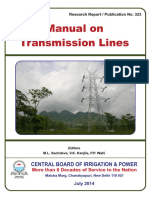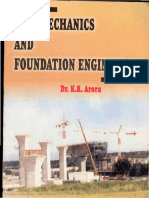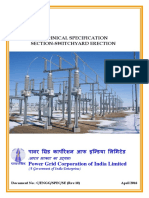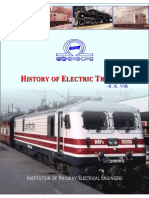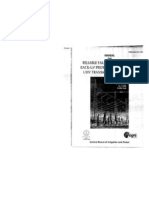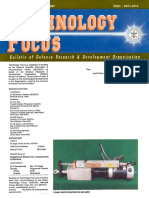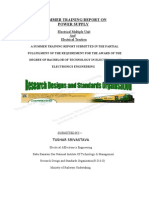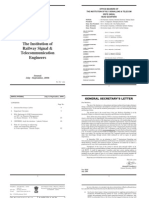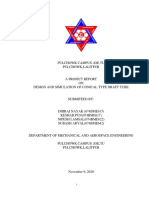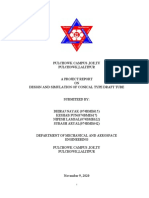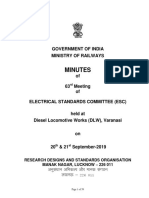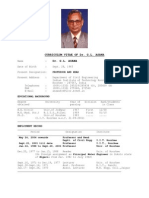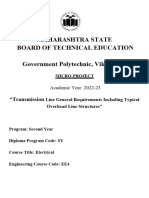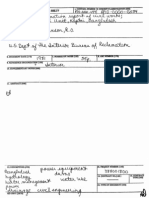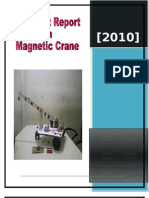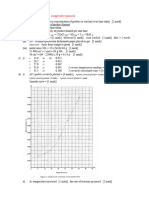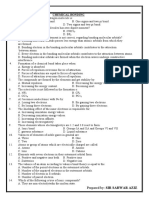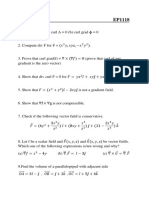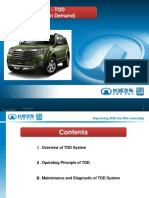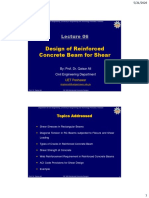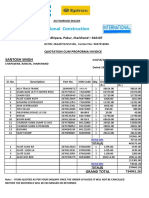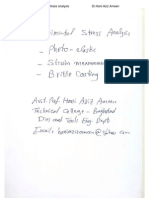Cbip Manual
Cbip Manual
Uploaded by
Abhishek Kumar SinhaCopyright:
Available Formats
Cbip Manual
Cbip Manual
Uploaded by
Abhishek Kumar SinhaOriginal Title
Copyright
Available Formats
Share this document
Did you find this document useful?
Is this content inappropriate?
Copyright:
Available Formats
Cbip Manual
Cbip Manual
Uploaded by
Abhishek Kumar SinhaCopyright:
Available Formats
:t~~~"\,
/~l'~--.::.,:,I'/.
,ul
*
I
I~
.:0
'f:';';,
__ ._",fi;;,-0~/'
I-.'.~,::~ f:Sr~-'911/~ -'-~~":..-'
j;,
"-==-====-~ ,;,\~
NEW DELHI
//;./.'
/*i
TRANSMISSION LINE MANUAL
Publication No. 268
Central Board of Irrigation and Power
Malcha Marg, Chanakyapuri, New Delhi - 110 021
CBI&P Panel of Experts on Transmission Lines
Editor
Chairman
D I\n Ahh I\A,~Ii~
'.J. Varma
( (
I,
(
(
(,
I,
,-,
:
;
............... _
_.._.•__
.,.
.._ H.......
.•._ _
__
.__ .._._
_-_. . , ...
TIIIIEfPlOJKIS Of
I I
.1
I
~
',.
___ run
,.0/22./132/66/33.V S•• IG1MANUFACTURER TRANSMISSION SWITCHYARD
.....'... 1'"
& EXPORTERS
TOWERS STRUCTURES
.,,J.,:<l""".
. {An'Associate'Co. of "';".-... _
ASSOC~IEDINSRAll''.'"•.
'.,,/{V'
MI CROW AVE/TELECOMMUNICATION
/.JA~~}:~'·
GAM~.oN--HOU.sE, 2nd . ~ VE~RSAVARKAR ':'PRABHADEVr, MUMBA TowE~RIEL~~a~l~.G0{rtx!n: 408
~".A~·'"
RAILWAY with Design,
TRACTION/ALLIED IN.HOUSE for Fabrication,
STRUCTURES FACILITIES "
complete
II
II
Hot Dip Galvanising
and
Construction, Erection, Commissioning
.....
REGO. OFFICE : 8. MATRU MflNDIR COMPOUND, 278 TARDEO ROAD.MUMBAI-400 TEL: ~89 303113032/303315 131/5132. FAX: 91-22·380 4242_ E-MAIL: u~abby@bom3.vsnl.net.in AOMN. OFFICE:
TEL.. ~20 833/327 I. BIRA. VENUS APARTMENT, PRODCTIVITY 629. FAX: 91·265·335530. 007. ROAD. VADOOARA 390 005.
WORKS: PLOT NO. 519·521. ASOJ VILLAGE. HALOL HIGHWAY, 015T. VAOODARA. GUJARAT. TEl. 7.:329/74379. FAX: 91·2668·74393
"
"
. •......•••..•••. '.••. i••..........•
:.'
'"
URJAGROUP
OF COMPANIES
CENTRAL BOARD OF IRRIGATION AND POWER
Established 11127
OBJECTIVES
• • • • • To render expertise in the fields of water resources and energy; To promote research and professional excellence; To provide research linkages to Indian engineers, researchers and managers with their counterparts in other countries andintemational organisations; To establish database of technical and technological developments, and provide information services; Technological forecasting. ACfIVlTIES 1. AdvancemtDt of Knowledge and Teehnologieal Forecasting
t!
.,':,.~.: t'.~ ci6rlecttbri'~dc6rnPiiati'on bf data and pooling ~ ~~:::
.: .. .. ,.~ M"";~~"~ " i
....
," '.".. _.,' .
'~'~''':, <.(f;:,,~.!J. ~
.:
$.
1;;~' _"'~, -: :..-.':":" ~'1'.: .:'.: ~.
~ '..:' .: ,•
oftechnical knowledge and experiences. ~p~p~o.Iro.f ~ba$esm water and power sectors in electronic format at the national level for easy access. ~::r.',n:; '.. ..* :lllntrOduci:{Ori and' implementation of Internet, Intranet. E-Business and E-Commerce for infrastructure ; ,·i r~. '.~;_../' t , fu.~i~ities... >: ; ':- .. ' .... :o'i.: ~; :.. / • :,,..' 0'.< Introduction of paperless office, flow charting and documentation management. !~'.{f' 1\ .:*!::: pissentinaticilof.iri£ojrnation - Library and information services . .~.,r ,: * Organisingnati~l and ~onal i seminars, symposia, conferences, workshops, roundtables, etc. ;,(t::"'~ ~ ,•. RecOghizingOUtstanding'contiibutions •. of engineers and managers by presenting them various CSIP awards.
'fttI,
~;,t:i
'.J~.
.. .' .",. ,1
Linkages with other Institutions/Committees/Organisations
(
Establishing contact - Exchange of infonnation and publications. Interaction with international organisations working in the fields of water resources and energy for the benefit of Indian professionals and for technology forecasting.
J. Publications • • Research project reports. Journals. Design,constructioo and management publications. Specifications/manuals/guidelines. Conference proceedings. Specific case studies.
*
• • •
4.
Research
* Assisting in specific case studies/problems. * Documentation.
5. Consultancy • •
Identifying research needs, sponsoring research projects. and monitoring R&D activities.
( (
Maintaining panels of experts/consultants for specific project works. Providing information to member organisations in the country. Identifying Indian expertise for specific needs of other countries, especially in AsiaJAfrica.
TRANSMISSION LINE MANUAL
1er
Publication No. 268
S.
Editors C.V.J. Varma P.K. Lal
CBI&P Panel of Experts on Transmission Lines P.M. Ahluwalia Chairman
CENTRAL BOARD OF IRRIGATION AND POWER
Malcha Marg, Chanakyapuri, New Delhi 110 021
STANDING PANEL OF EXPERTS ON TRANSMISSION LINES
Chairman P.M. Ahluwalia Ex-Member, CEA
Members
1. V.N. Rikh Ex-Chairman, UPSEB V.D. Anand Ex -Chief Engineer, CEA M.L. Sachdeva Ex-Chief Engineer, CEA Chief EngineerlDirector (Trans. Design), CEA Umesh Chandra D. Chowdhury AGM DGM Power Grid Corpn. of India Ltd. S.N. MandaI, Chief Design Engineer NTPC/K. Mohan Das, Addl. Chief Design Engineer, NTPC Convenor P.K. Lal Director (E) Central Board of Irrigation and Power 7. 8. 9. 10. 11. Executi ve Director/Chief Engineer (Trans. Design), UPSEB Executive Director/Chief Engineer Transmission Designs, MPEB Executi ve Director/Chief Engineer Transmission Design, GEB Director Bureau of Indian Standards Vice-President (Engineering)/General Manager Engineering, KECIL-RPG Transmission Vice-President (Technical) EMC
2. 3.
4. 5.
6.
12.
AUTHORS
Chaper 1 Introduction P.M. Ahluwalia V.N. Rikh V.D. Anand Tower Types and Shapes Tower Geometry M.L. Sachdeva H.S. Sehra Electrical Clearances M.L. Sachdeva Design Parameters Loadings Umesh Chandra D. Choudhury Design of Towers Testing of Towers S.D. Dand L. Khubchandani
ASSOCIATED TRAN,SRAlL STRUCTURES lTD.
Chapter 2 Chapter 3
(An Associate Co, of Gammon Group)
Chapter 4 Chapter 5 Chapter 6
GAMMON HOUSE, 2nd FLOOR, VEER SAVARKAR MARG, PRABHADEVI, MUMBAI·400 025. TEL:5661400~1 ::xtn: 4086/4043
Chapter 7 Chapter 8
Chapter 9 : Tower Materials, Fabrication, Galvanisation, Inspection and Storage B.N. Pai Chapter 10: Design of Foundation S.M. Takalkar D. Choudhury Construction of Transmission Lines M.V. Subbarayudu
Chapter 11:
Each Chapter was finalised after Intense input by Shri P.M. Ahluwalia, Chairman of the Panel Covering Detailed Review, Modifications and Supplements followed by final Discussion and Acceptance by the Panel of Experts.
OTHER CONTRIBUTORS
1. 2.
.-".~.
i,c Jain, Ex-Member, CEA
H.S. Sehra, Ex-Director, CEA
~!~!"',J
f'_
3.. Powergrid Corpn. of India .:"iP'f't. • .• _'~'-r.. ",~ r » . fT".'s.; .~,: .....l}. -..: ~.. . " ~. ;' -',..,.i- ..~ .1IC.... p:Ut.·nwiYe'di
< .~ '''' ", ~
Vipin Parikh VP. Nathwani 10. SAE, New Delhi
.~ ~ '~"-. ; ... '-; ,~.
;1
TI .9
"';'.'"",W! y\ ~.
~" : . " -"
i' ~
:)<rj~~na~!W\w .....
"-S~M..... S'a~eria:;.~.."
~f""
f '~, ,',.
wi
'~"
..,-\
"'
.r r.
:'.
i ,,_',~ r". :,' e• ~
•.•.••.
,":ItV.'S:
."'RajeshTiupta, '-'.
~iasaa..>" ',".,J - ~ ,'_. : :.. .' G.K.~sh~tma; .. :;<? ~~.'~'~-' /:',.;.~'
r.. .
.. :-EV.. R,(,lO · • ,";' " .r. ': ;._:~',' '.oj .,;~ 4. ". 'C~~tral Electricity Authority' .
V Narayanan Dr. D.M. Lakhapati M.K. Mukherjee P. Bhattacharya N.T. Makijani RJ. Kulkarni Arun Arora 11. EMC Limited Dr. P. Bose D.K Roy
12. Transrail Engg. Co. Pvt. Ltd., Mumbai
st
t)f
eo
on
S.L. Narasimhan D.P. Kewalramani Raisuddin Karnail Singh A.K Jain P;S. Aggarwal Alok Gupta Neeraj Kumar
..e AI
D.C. Bagde 13. BHEL, Bangalore S. Chandra 14. UPSEB, Lucknow VB. Singh Virendra Prakash A.N. Sinha Surendra Narain VK Srivastava A.K. Tiwari 15. G EB, Vadodara
V,J,
(
1't
)
NI
ill
,f
5.
NHPC, Ltd. S.B.C. Misra G.c. Tather VP.M. Nair S.N. Dubey
"C
.....t
'1I(
au
(J
6.
NTPC Ltd. L.V Rao A.P. Shatru S. Dasgupta
'h
Tr.
in
Ambawani KS. Dave
,
7. 8.
ABB, New Delhi Mata Prasad SERC Ltd., Chennai K. Murlidharan SJ. Mohan
16. MPEB, Jabalpur S.Z. Hussain Ashok Bajpai 17. MSEB, Mumbai AJ. Khan Ltd. 18. BIS, New Delhi S.K Gupta S.S. Sethi Rachna Sehgal W.R. Paul 19. GERI, Vadodara U.D. Datir
th,
9.
KEC International L. Khubchandani S.D. Dand G.D. Rathod B.N. Pai M.V. Subbarayudu M.N. Dedhia P.L. Sehgal
The Central Board of Irrigation and Power brought out a manual on "Design of Transmission Line Towers" in 1977. The publication proved immensely popular and had to be reprinted twice because of its usefulness to utility engineers and manufacturers of transmission line towers. There have been many important developments since publication of the manual in 1977. The central sector generating companies like National Thermal Power Corporation and National Hydro Power Corporation made considerable impact on the generation scenario as also on EHV systems required for evacuation of power from the generating stations and also on inter-connection between various states for integrated system operation within the region. The regional grids are all in operation now and Power Grid Corporation of India is engaged in the task of establishment of National Power Grid. There have been considerable technological developments in the field of transmission engineering and the HVDC transmission and 800 kV transmission are going to play an important role in the National Power Grid. It was, therefore, felt necessary not only to revise the manual published earlier but also to make it a comprehensive one to include not only towers but also other aspects of transmission lines incorporating latest technological developments. Keeping this in view the Central Board of Irrigation and Power constituted a panel consisting of eminent transmission lines experts from all over the country in 1988-89 under the chairmanship of Shri P.M. Ahluwalia, Ex-Member, CEA, New Delhi to take up this important work. . This Panel of Transmission Experts further set up in March 1992 a Steering Committee and also a Working Group to consider and make suitable recommendations on the implications of the proposed draft amendment to the Indian National Standard IS:802-1977 "Code for use of Structural Steel in Overhead Transmission Line Towers" issued in 1991 based on the 1987 draft on the report oflEC 826 of Intemational Electro-technical Commission. The outcome of efforts made by Steering Committee led to adoption of the probabilistic method of design as contained in "Guide for New Code of Transmission Line" published by CBIP in 1993. These recommendations were adopted in Part-I of IS-802 published in 1995. The present document "Manual on Transmission Lines" is outcome of the ceaseless efforts made and voluminous work done by the Panel of Experts on Transmission Lines. The various chapters contained in the publication were authored by groups of eminent practising experts and were thoroughly discussed in the meeting of panel at the time of finalisation. This publication will be immensely useful to Managers, Design and practising engineers of power utilities and Transmission Line Companies, Researchers, Testing Stations, Faculty Members and Students of Engineering Institutes in India and overseas. The Central Board of Irrigation and power wishes to acknowledge its grateful thanks to the authors of the different chapters for their expert contribution. Special thanks are due to Shri P.M. Ahluwalia, Chairman of the panel for the tremendous input and direction given for finalising the manual. Shri V.D. Anand, Chief Engineer (Retd.), CEA took it upon himself to go through the final manuscript meticoulously and correcting the same. The Board is also thankful to the members of the Committee for their valuable contribution. It is hoped that this publication will be well received by the engineering fraternity.
(C.V.J. VARMA) Member Secretary Central Board of Irrigation and Power
Vll
il
..J
1
(
Power projects are highly capital intensive. Transmission Line is the vehicle for optimum utilisation of power produced at power projects. Transmission Line suffers from limitless insurmountable handicaps - Funds, Environment, Ecology, Proximity of Objects. Forests, Right of Way, Changing Hostile Terrains, Uncertainties of Wind, Temperature, Snow and Lightning, and above all requirements of Reliability, Security and Safety. Overcoming all these adversities Transmission Line has to deliver to the consumer power at minimum cost and with maximum reliability. Tower is the most critical component of Transmission Line. CBI&P published in 1977 "Manual on Transmission Line Towers". That document became very popular in India and Overseas with Power Utilities and Tower Manufacturers. It had to be reprinted two times in 1988-89, CBI&P set up a Panel of Experts on Transmission Lines to review the Document considering the latest technological developments. In India, Towers were designed following Deterministic Method of Design as per Indian Standard, IS:8021977 Code of Practice for Use of Structural Steel in Overhead Transmission Line Towers. For almost a decade since 1980, CIGRE and IEC worked on the Probabilistic Method of Design for Overhead Lines, culminating in the publication of the Recommendatory Report IEC 826:1991, based on which CIGRE Working Group 22.06 sent a Questionnaire to various countries of the World, including India. The CBIP Panel of Experts on Transmission Lines examined the subject with speed and in depth through Steering Committee of top-most Transmission Experts. As a result India was one of the first countries in the world to adopt the Probabilistic Method of Design as contained in the sister Publication of CBI&P "Guide for New Code for Design of Transmission Lines in India" -1993. In accordance with the CBI&P Guide, Indian Standard IS:802" Code of Practice, for Use of Structural Steel in Overhead Line Towers" Part 1, Section 1 "Materials and Loads has been amended and published in 1995. Chapters 5 - Design Parameters -6 -Loadings; and 7 -"Design of Tower Members; of the Present Document deal with this subject. Other subjects dealt with in the Document are: Tower Types and Shapes - Chapter 2; Tower Geometry - Chapter 3; Electrical Clearances - Chapter 4; Testing"of Towers - Chapter 8; Tower Materials, Fabrication Galvanising Inspection and Storage - Chapter 9; Design of Foundations - Chapter 10; and Construction of Transmission Lines - Chapter 11. Each one of the Chapters was authored by eminent practising Experts incorporating latest technological advancements and practices and reviewed in depth by the members of the Panel of Experts on Transmission Lines before adoption. Special attention was given towards simplicity, clarity and completeness to make each chapter self-contained in all respects giving practical examples of calculation to facilitate practical application without hinderance. The Document has full acceptability as the Panel comprised managerial experts from Central Electricity Authority, Central Government Power Corporations, State Electricity Boards, Bureau of Indian Standards, Tower Testing Stations, Research Institutes and Transmission Line Manufacturing and Construction Companies. The mass of technological work could be accomplished by the untiring labours of the authors, members of the Panel of Experts and their organisations who worked behind the scene, CBI&P Management, Shri C.V.J. Varma, Member Secretary and Shri P.K. Lal, Advisor and other officers and staff of the CBIP. They worked ceaselessly for almost 9 years. lowe limitless gratitude and personal thanks to them for their co-operation and kindness in this great technical endeavour.
IX
Power utilities, Transmission Line companies and their engineers located in the far-flung corners of India were always faced with the dearth of a single unified document on Design, Manufacture and Construction of Transmission Lines. This Manual will fill that void. It will be of great reference value to the Management and Practising engineers of Power Utilities and Transmission Line Companies, Researchers, Testing Stations, Faculty Members and students of engineering Institutes in India and Overseas.
P.M. AHLUWALIA Chairman CBIP Panel of Experts on Transmission Lines
Foreword Preface ~: Introduction 1.1 1.2 1.3 1.4 1.5 1.6
1.7
Preamble Development of Power Systems in India Environmental and EcologicalAwakening Privatisation Wave - Impact on Transmission Systems in India Philosophies in Design of Transmission lines New Concepts in Transmission Line Design Resume of Topics Covered In the Manual
\_ 2.
Tower Types and Shapes
2.1 Scope 2.2 Types of Towers 2.2.2 Self-SupportingTowers 2.2.3 Conventional Guyed Towers 2.2.4 Chainette Guyed Towers 2.3 Tower Shapes 2.4 Tower DeSignation 2.4.2 Suspension Towers 2.4.3 Tension Towers 2.4.4 . Transposition Towers 2.4.5 Special Towers 3. Tower Geometry 3.1 3.2 3.3· 3.4 3.5 3.6 3.7 3.8 3.9 Scope Tower Anatomy Bracing System Tower Extensions Tower Outline Tower Height Tower Width Cross-arm Spread Typical lengths of Insulator Strings on Transmission Lines in India
4.
Electrical Clearances
4.1 Introduction 4.2 Minimum Ground Clearance 4.3 Minimum Clearance above RiverslLakes 4.4 Environmental Criteria for 800 kV line . 4.5 Air Clearances - General Consideration 4.6 Clearances and Swing Angles on Transmission Lines in India 4.7 Conductor Metal Air Clearances
XI
4.8
4.9
4.10 4.11 4.12 4.:13
Air Clearance - Analysis by CIGRE . Phase-to-Phase Air Clearances Clearance between Conductor & Groundwire Effect of Span Length on Clearances Clearances at Power Line CrOSSings Recommendation
ANNEXURES
Annexure I - Spacing between Conductors Annexure II - 'Swing Angle for 800 kV Anpara - Unnao Line for Insulator Strings and Jumper APPENDIX - Investigation Studies on Clearances and Swing Angles for Indian Power System
I
.5~
Design Parameters
5.0 5.1 5.2
5.3 5.4
5.5 5.6
5.7
5.8
Abstract Transmission Voltage Number of Circuits Climatic Ocndhions Environmental and Ecological Consideration . Conductor Earth Wire Insulator Strings Span
6.
Loadings
6.1 6.2 6.3 6.4 6.5 6.6 6.7 6.8 6.9 6.10 6.11 6.12 6.13 _6.14 6.15 6.16 6.17 7.
Introduction Requirements of Loads on Transmission Lines Nature of Loads Loading Criteria Transverse Loads (TR) - Reliability Condition (Normal Condition) Transverse Loads (TS) - Security Condition Transverse Load (TM) during Construction and Maintenance - Safety Condition Vertical Loads (VR) - Reliability .Condition Vertical Loads (VS) Security Condition . Vertical Loads during Construction and Maintenance (VM) - Safety Condition Longitudinal Loads (LR) -Reliability Condition Longitudinal Loads (LS) - Security Condition Longitudinal Loads during Construction and Maintenance (LM) • Safety Condition Loading Compinations under Reliability, Security and Safety Conditions Anti-cascading Checks . Brokel1wite Condition Broken Limb Condition for 'V' Insulator String
Design of Tower Members
7.1 General
7.1.1 Technical Parameters
7.3 7.4
7.5 7.6 7.7
7.8
7.9
7.2.2 Graphical Diagram Method 7.2.3. Analytical Method 7.2.4 Computer-Aided Analysis 7.2.4.1 Plane - Truss Method or, 2-Dimensional Analysis 7.2.4.2 Space - Truss Method, or 3-Dimensional Analysis 7.2.5 Comparison of Various Methods of Stress Analysis 7.2.6 Combination of Forces to determine Maximum Stress in each member Member Selection Selection of Material 7.4.1 Use of hot rolled angle steel sections 7.4.2 Minimum Flange Width 7.4.3 Minimum Thickness of Members 7.4.4 Grades of Steel Slenderness Ratio Limitations (KUR) Computation of UR for Different Bracing Systems Permissible Stresses in Tower Members 7.7.1 Curve-1 to Curve-6 7.7.2 Reduction due to bIt Ratio Selection of Members 7.8.1 . Selection of Members in Compression 7.8.2 Selection of Members in Tension 7.8.3 Redundant Members Bolts and Nuts
Annexures Conductor Details I
II III IV Earthwire Design Loads Graphical Diagram Method Analytical Method Computer Aided Analysis Input for 3D Analysis Output Giving Summary of Critical Stresses Chemical Composition and Mechanical Properties of Mild Steel Chemical Composition and Mechanical Properties of High Tensile Steel Section List Equal Section Commonly Used for Towers & As Per IS:808 (~art - V) 1989 UR Consideration for Bracing System ·in a Transmission Tower Permissible Axial Stress in Compression Reference Table for Maximum Permissible Length of Redundant Members Dimensions for Hexagon Bolts for Steel Structures
V
VI VII VIII IX X XI XII XIII XIV XV
8.
Testing of Towers
8.1 8.2 8.3 8.4 8.5 8.6 8.7 8.8 8.9 Introduction Testing Requirements Description of a Tower Testing Station Calibration Assembly of Prototype Tower Rigging Arrangements and Location of the Loadcells Test Procedure Testing of Prototype Tower Special Requirements
XIII
!.'.-,
8.10 Acceptance of Test Results 8.11 Material Testing 8.12 Presentation of Test Results
9.
Material, Fabrication, Galvani$ing, Inspection and Storage
9.1 Scope
9.2 " Material Quality Control 9..3 Specific Requirements of Fabrication 9.4 Operations in Fabrication
9.S 9.6 9.7
9.8 9.9
Tolerances Shop ,Erection/Proto-type Tower Assembly Galvanising Inspection Packing and Storage
I
Annexures II
III
IV V VI VII
Chemical Composition and Mechanical Properties of Mild Steel Chemical Composition and Mechanical Properties of High Tensile Steel " (a) Properties of Equal Angle Sections as per IS : 808 (Part V) - 1989 (b) Properties of Unequal Angle Sections as per I~ : 808 (Part V) - 1989 (c) Properties of Channel Sections Unit Weight of Plates Dlmenslons of Hexagon Bolts for Steel Structures Ultimate Strength of Bolts Properties of Anchor Bolts. Metric Screw Threads as per IS : 4218 (Part-3)-1976 with ISO
Appendices
Appendix I ; Quality Assurance Plan I. Introduction II. Quality Objective" III. Quality Policy IV. Organisation of Quality Control Department V. "Quality Planning VI. Design and Drawings VII. Company Standards " VIII. Control on Inspection-EquipmentsIToolsiGauges IX. Material Management X. Incoming Material Inspection XI. Pre-production XII. In-Process Inspection XIII. Inspection and Testing of Finished (Galvanised) Material XIV. " Storage, Packaging and Handling Enclosures - A Sampling Plan for Incoming Material a. Sections, Accessories and Bought out Items b. Sampling Plan for Physical Properties"of Bolts, Nuts and Spring Washers c. Sampling Plan for Galvanising"Test for Threaded"Fasteners " d, Formats for Inspection Report for Steel StackinglPreliminary-(QCD-I) e. Format for Report on Bend Test f. Format for Report on Testing of Physical Properties
. • "._ --- ...:_- Q"nnri fnr
"\
Rnlt~lNuts.(QCD-2)
k. I.
Format for Inspection Report for Accessories - (QCD-4) .' Format for Inspection Report for Steel Test Tower - (QCD-5) Plan for In-process Material Procedure Format for Quantity Control Report Format for Loading Report of Crates Format for Inspection and Loading Report of Fabrication Shop Format for Inspection and Loading Report of. Model Assembly Format for Inspection and Loading Report of Model Shop Format for Out-right Rejection Slip Format for Rectifiable Rejection Slip Format for Weekly Records of ShiftWise Acid Strengths Format for Galvanising Process Inspection Report Format for Galvanising Inspection Report Format for Testing Concentration of Prefluxing and Degreasing Solutions
.,'
B. Sampling (a) (b) (c) (d) (e) (f) (g) (h) (i)
G}
(k) (I)
Appendix II: List of Machines required for a well-equipped Tower - Fabricating Workshop Appendix III : Workshop Chart Appendix IV : Process Flow Chart for Fabrication of Tower 10. Design of Foundations 10.1 General 10.2 Types of Loads on Foundations 10.3 Basic Design Requirements 10.4 Soil Parameters 10.5 Soil Investigation 10.6 Types of Soil and Rock 10.7 Types of Foundations 10.8 Revetment on Foundation 10.9 Soil Resistances for Designing Foundation 10.10 Design Procedure for Foundation 10.11 Concrete Technology for Tower Foundation Designs 10.12 Pull-out Tests on Tower Foundation 10.13 Skin Friction Tests ·10.14Scale Down Models of Foundation 10.15 Tests'on Submerged Soils 10.16 Investigation of Foundation of Towers 10.17 Investigation of Foundation of a Tower Line in Service 10.18 Repairs of Foundations of a Tower Line in Service 10.19 Foundation Defects and their Repairs Annexures Annexure . Annexure Annexure Annexure -I - II - III - IV
xv
,
Typical Illustrations Tower Foundation Design Calculation Illustration - I Illustration • II Illustration - III Illustration • IV Illustration • V Illustration - VI Illustration • VII Illustration - VIII Illustration • 'IX Illustration - X 11. Construction of Transmission Lines 11.1 11.2 11.3 11.4 11.5 11.6 11.7 11.8 11.9 11.10 11.11 11.12 11.13 Survey Manpower, Tools and Plants and Transport Facilities EnvironmentalConsideration Statutory Regulation for Crossing of Roads, Power Lines, Telecommunication Lines, Railway Tracks, etc. Surveying Methods Foundations Erection of Super Structure and Fixing of Tower Accessories Earthing Stringing of Conductors Hot-Line Stringing of E.H.V. lines Protection of Tower Footings Testing and Commissioning References
Annexures
~ I
Transmission Line Manual
Chapter 1
Introduction
CONTENTS
Page 1.1 PREAMBLE 1.2 DEVELOPMENT OF POWER SYSTEMS IN INDIA 2 2 2
3 3
i·
1.3 ENVIRONMENTAL AND ECOLOGICAL AWAKENING 1.4 PRIVATISATION WAVE - IMPACT ON TRANSMISSION SYSTEMS IN INDIA 1.5 PHILOSOPHIES IN DESIGN OF TRANSMISSION LINES 1.6 NEW CONCEPTS IN TRANSMISSION LINE DESIGN 1.7 RESUME OF TOPICS COVERED IN THE MANUAL
'3
" I
,
1.
i.
1
I
(
I ' (
~
I
,.
I
]
1: C
'.
'.
I
e
d 1 s
C
\
, ,
'.
1
S1 . f(
"
.l
'd
I
\11
\.
ca
11
.C
TRANSMISSION liNE MANUAL INTRODUCfION
1.1 PREAMBLE 1.1.1 Electrical energy, being the most convenient and cleanest form of energy, is finding the maximum usage the world over for development and growth of economy and therefore generation, transmission and utilisation of the same in ever increasing quantities as economically as the latest technological advancements permit, are receiving great attention. The technical, environmental and economic considerations involved in siting and development of power generation projects required for meeting the demand for electrical energy are gradually resulting in longer transmission distances and introduction of higher and higher transmission voltages, and use of high voltage direct current transmission systems. Thus transmission systems with voltages of 800 kV ae and t 600 kV de are already in operation in some of the countries and those with 1000/1100 kV ac and ± 750 kV dc have also been introduced 'n some countries. In India, 66 kV, 132/110kV, 230/220 kV, and 400 kVae. and ± 500 kV dc systems are already in service and 800 kV ac systems are in the process of implementation. All these systems owe there reliable performanee to a great extent to dependable transmission lines. Tower constitute a very vital component of transmission lines, as these performs the important functions of supporting the power conductors and overhead ground wires at the requisite distances above ground level and maintaining appropriate inter -conductor spacings within permissible limits under all operating conditions. 1.1.2 With increase in transmission voltage levels, the heights as well as weights of towers have also increased and so has their cost. The transmission line towers constitute about 28 to 42 percent of the cost a transmission line. Therefore optimisation of designs of towers can bring about significant economy in the cost of transmission lines .: It is therefore imperative that transmissionline towers are designed so as to make use of materials and workmanship most effectively and efficiently. 1.1.3 The weight of a tower required for any specific applications is influenced to a great extent by the selection of tower configuration, choice of steel structurals for tower numbers, typ.e of tower, types of connections etc. On the basis of experience and designing skill, a tower designer can produce tower designs conforming to the governing specifications and bring about optimum reduction in tower weight without sacrificing stability and reliability features of the finished tower which are very important for structural reliability of a transmission line. These depend not only on the designs of tower and its foundation but also on the type of tower, development of structural arrangement of tower numbers, detailing of connections, quality of steel structural, accuracy in fabrication, proper soil investigations, use of foundations according to soil conditions at sites of tower installation, accuracy and adequate care in tower erection and proper maintenance of the erected towers. 1.1.4 Depending on the manner in which the towers are supported these fall in the following two broad categories :. 1. Self supporting Towers 2. Guyed Towers This Manual covers all aspects of designs of self supporting comprehensive manner. towers and their foundations in a
~ ~
1.~
DEVELOPMENT OF POWER SYSTEMS IN INDIA
1.2.1 In India, development of power over the years has been phenomenal. The installed generating. capacity has risen from a mere 2301 MW in 1950-51 to 85940 MW on 31st March, 1997. Matching with the installed generating capacity, transmission Systems have also grown. In 1950-51 there were only about 2700 Circuit KM of 132 kV lines and 7500 Circuit Km of 66/78 kV lines. These have grown to about liOO Circuit Km of 500 kV of HYDC lines, 32200 Circuit Km of 400 kV lines, 76400 Circuit Km of 220 kV lines, 97200 Circuit Km of 132 kV lines and 37700 Circuit Km of 66 kV lines (total 245,200 Circuit Krns). Strong interconnected transmission networks have been developed by each Electricity Board within the State boundaries. Regional Grids interconnecting State Transmission Grids have been built facilitating uninterrupted transfer of power within the region. National Grid at 800 kV and 400 kV is in the process of coming up spear-headed by Power Grid Corporation of India. Highlights of the power systems in India are given in Exhibits Ll to 1.7. International comparisons with other countries are given in Exhibits 1.8 and 1.9.
1.3
ENVIRONMENTAL AND ECOWGICAL AWAKENING
1.3.1 Environmental and ecological considerations were not given so much importance in the past in the designs of transmission lines and their routing. However, availability of more sophisticated facilities has made it possible to investigate into the effects of electric and magnetic fields associated with transmission lines and understand and better appreciate the possible adverse effects of the above fields. In order to ensure that these fields least affect the way of life and ecology, the conductor configuration, tower shapes and transmission line corridors are so chosen that the magnitudes of radio interference (RI), television interference (TVI), audio noise (AN) and electrostatic fields radiated by the transmission lines are within safe limits and ecology is affected the least.
1.4
PRIVATISATION WAVE· IMpACf ON TRANSMISSION SYSTEMS IN INDIA
i. ,
1.4.1 Exhibit No.l.lO gives an idea of the sector wise utilisation of funds as well as the total funds allocated for Power from 1951 to 1992 and the outlay for the 8th Five year Plan period. It shows that against the norm of at least 50% of the total allocated funds being utilised for Transmission and Distribution, the average availability of funds for Transmission and Distribution over the years 1951 to 1997 has been 32% only. This has resulted in lopsided development of T&D systems leading to most of the chronic problems faced by the consumers. 1.4.2 Development of power systems being highly capital intensive but essential for overall growth of economy, induction of Private Sector in the development of generation as well as T&D systems is engaging the attention of the Govt. of India. Some headway has been made as regards generation projects. However, the same has yet to take place for the T&D sector. With privatisation coming through for this sector also, the transmission system will get impatus for faster development. . 1.4.3 Need-based funds for development of transmission and distribution system during the 9th Plan period are of the order of about Rs. 110 thousand crores. These are over and above the funds required for generation projects which are about Rs. 160,000 crores for the 9th Plan period. It may not be physically possible for the country to make available funds of this order in the Pu blic Sector. Privatisation of generation projects is already underway. Many IPPs have sponsored power generation projects which are actually not coming up physically. The main bottle-neck is transmission and distribution. Unless a Private Sector Company has the facility to make returns from the power project, their interest in actual execution will be limited. For privatisation in Power Sector to take momentum, it is imperative for privatisation to take place in transmission and distribution, not limiting to power generation only.
'-;'
"
·f
mg.
r .• (11v
1.5
PHIWSOPHIES IN DESIGN OF TRANSMISSION UNES
out ?~"
:uit
ta.J
.:,~
Before IEC:826 - "Report on Loading and strength of overhead lines' came out in 1985, 1987 and 1991, the design of transmission lines in India as also in several other countries was made as p.er design philosophy based on deterministic concept of Loadings and strengths with specified factors of safety {or the different operating conditions. Consequent to consideration of the approach outlined in IEC " 826. design philosophy based on probablistic concept with provisions relevant to Indian experience has been finalised for Transmission Line design and the existing 15:802 (Part I/Section 1) - 1995 code of practice for use of structural steel in overhead line Towers has been recast accordingly .
sin
~.:
1.6
NEW CONCEPTS IN TRANSMISSION UNE DESIGN
The new concepts in transmission line design philosophy include the followi 19 major changes in the design method(i) Design based on limit load concept;
t~~
(ii)
(iii)
Use of probablistic method of Design; Use of Reliability levels in transmission lines design;
has
;. I
to
Y \ ,
wer
.nes
(iv) Use of Co-ordination in strength of line components; (v) Use of six basic wind speeds converted to 10-minutes average speeds corresponding to 10-meter height over mean retarding surface as the basis for wind loads on transmission lines instead of three wind zones corresponding to 3D-meter height over mean retarding surface in use earlier; (vi) Consideration of the effects of terrain category and topography of transmission line corridors in the design wind speeds; and (vii) Carrying out anticascading checks on all angle towers 1.7
RESUME OF TOPICS COVERED IN, THE MANUAL
.nds
tAt
ilnd
1[0
s' f
1.7.1 The topics covered in chapters 2 to 11 of this Manual are briefly described below. 1.7.2 Chapter 2 - Towers types and shapes 1.7.2.1 This chapter describes fully the types of towers, tower shapes and designation of towers and brings out the essential differences between the various types of towers and the factors for preference of a particular type of tower to other types for some specific considerations.
h of
ung
1.7.3Chapter 3 . Tower Geometry
1.7.3.1 'This chapter describes the various portions of towers and details the factors which determine tower height, tower width at various levels and the spread of cross-arms. It also describes the various types of bracing systems, insulator stings, and gives details of their composition, typical details of 66 kV,' 132 kV, 220 kV and 400 kV insulator strings, values of angles of swing and corresponding electrical clearances for insulator strings and jumpers for transmission lines already in service in India. analytical calculations of electrical clearances on transmission lines etc. 1.7.4Cliapter 4 . Electrical Clearances
f:
:t
ired
.t;"n eets
:: \ 1.
t ..Ie
heir n, It
r 'r
1.7.4.1 This chapter covers the requirements regarding the minimum electrical clearances to be maintained at tower and at mid-span between live parts of transmission line and from live parts to tower members for the various types of over voltages to which transmission lines of different voltage levels are subjected in service. It also deals with the minimum ground clearances, effect of span length on clearances and
the requirements regarding electrical clearances circuits. railway tracks rivers, lakes etc.
1.7 .5Chapter 5 - Design Parameters
of power lines crossing over tele-communication
.d'
J,
1.7.5.1 This chapter considerations which of lee-ward conductors significance in tower 1.7.6Chapter
covers the electrical, climatic and geological environmental and ecological influence the designs of transmission lines. It deals with the effects of shielding by the wind-ward conductors of bundle conductors, span terminologies and theirdesign, conductor creap allowance etc.
6 - loadings
tit el ,I
01
••
1.7.6.1 This chapter defines the various types of loads. gives methods for their estimation for snow-free regions. deals with the Reliability Requirements - climatic loading under normal condition security requirements - Failure containment under broken wire condition, safety requirements loadings under construction and Maintenance and Anticascading Requirements 1.7.7 Chapter 7 - Design of tower-members 1.7.7.1 This chapter describes the methods of analysis of stresses in plane trusses and space frames, and deals with selection of grades and sizes of steel structurals for tower members, use, of high tensile steel and mild steel sections, slenderness ratio limits for members with calculated and uncalculated stresses. built-up members, permissible stresses in tower members and bolts, design of tower members and member connections. 1.7 .8 Chapter 8 - Testing of Towers 1.7 .B.1 This chapter deals with the purpose of testing of towers, describes a typical tower testing station, celebration of load cells, rigging arrangements, locations of load cells in the test set- up, testing procedure, sequence of test loading cases. acceptance of test results and testing of tower material. 1.7.9Chapter
.
.
9 - Tower Materials, Fabrication, Galvanization, Inspection & Storage
1.7.9.1 This chapter deals with Material quality control, specific requirements of Fabrication covering preparation of structural assembly Drawings, shop Drawings and bill of materials, cutting means, operations in Fabrication such as straightening, cutting )i.e cropping, shearing, cutting, or saucing), binding, punching, drilling and marking tolerances, shop erection (horizontal or vertical), Method of Galvanising, Inspection as per quality assurances plan, packaging of finished members and their storage. The chapter highlights the significance of planing as it has great bearing on optimum utilisation of material and limiting the wastage. The chapter contains data on permissible Edge Security and Bolt Gauges, chemical and mechanical properties of Mild and High tensile steels, Properties of Equal! Unequal Angles, channels, Plates, Bolts/Nuts, and Anchor Bolts, it also contains a sample QAP, list of Tower Fabricating, Machinery; details of Galvanising Plant. and the tests conducted on fabricated members.
1.7.10 Chapter 10· Design of Fuundations
1.7.10.1 This chapters deals with design requirements for various types of foundations for self - supporting towers. It brings out the importance of soil investigations and testing. classification ui soils and excavations types of foundations and their application areas, procedure for their dC$igr,s etc. The chapter contains the permissible values of soil bearing capacities. permissible stress vahu ': (,II concrete, reinforcement bar details and procedure for testing of foundations. Application of Ih~<::jl" Methods is
demonstrated by typical detailed calculations of designs for aifferent types of Foundations."; he cnapter describes methods for investigating foundations and carrying out their repairs during construction 'stage and on lines in service.
11
b
1.7.11 Chapter 11 • Construction of Transmission Lines 1.7.11.1 This chapter covers all the stages from reconnaissance survey up to commissioning of lines. It deals with statutory regulations, line corridor selection from environmental angle, methods of tower erection, paying out of conductors under uncontrolled and controlled tension, final sagging, clamping in. spacer Ivibration damper/spacer damper instaJIation, jumpering, live line stringing of EHV lines, protection of tower footings etc. It also covers the tests to be conducted before line energisation.
ir·
E'
~el
109
I. ,
: uf
y'.
~of
,(,1/
r'
k.(
t of
t1
:.!
L,e
and
Is is
EXHIBIT 1.1 Plan Outlays for Power Sector
(Rs. Crores) For Plan First Plan (1951·56) Second Plan
(195&-61) 310 116 321
Generation-
T&D
Total
Z83
110
393 426
1020
Fourth Plan (1968-74) Fifth Plan
(1975--80)
699 1725
722
5413
9185,
2447 19264
34272 79571
Sixth Plan
(l98Q..85)
13851 25087
57291
Seventh Plan
(198~90)
Eighth Plan
(1992-97)
22280
NinthPlan '(1997-2002)
1,40,000
1,10,000
asoroc
I
t
O+------y----~r-----~~--~-
EXHIBIT 1.2
Installed Generating
Year 1~F)!) S I
1<11)01;1
1~!71l71
Capacity
(MW)
Nuclear
0
I,',
Hydro S5~
Thermal
Tolal 2Wl 4653
J.tfil3
1742 2736 7810
15207
1917
6J83 10883
421;
li·lll ItllJ:l
1~J7X,t~1 19848::,
2!)i31i 4:L~S
14460 18307 18753
19194
19576
27030 43764 45768
48086
1989-90
19<j{~91 19~192 199:L,9:{ 1!193-94
1565 IS/iS 1,X')
20(1:')
63636
66086
6906S
50749 54370 58110
60086 61149
723jli 76754 80944
20DS
20379 20829 20976 21fi45
19~'4-~5
1995-%
19Y6,97
2005
222S
")')')
..~
8J287
85019
r:. .... ,)
<:OOX>
soeoo
'7(XXX}
60000
~ ~
mx> ~
J(XXX)
ro'XJ
I~~I
1%0-61' 1~71
19'7S-19 I~
~90
1mg1 1991-92 ~93
1993-94 1~
1m-96
1996-97
y-
EXHIBIT 1.3
Electricity Generation
(LW~L \1l:)
Year 1950 ..51 1960-61 1970-71
Nuclear
0 0 1339
Hydro
Thermal
Total 5~58
lti937
2860 7837 25248 52594 53948 62116
. 71640
~!i98 !iIOO
29961
i.a \'. ·11 }-i''!
(O1)
5f:i548
lli2S23 1568[)9
1978-79 i584 .. 5 8
1989-90
2770
4715~J
9883€i
4075·
4625
6140 5530
178697 186550 208740 224760 24819()
267891""
245438 264330
287030
2:i1), l~ll
1990-91 1991 .. 92 1992·93 1993-94 1994·95
1995-96 1996-97
72760 69870 70460 82511
72383
6730
5400
7s, {
301360
324050
3S6i'l54
}l
5646
7923
299470
317158
:179776
9024
68618
394800
"-'0000
.Q)OO)
3~ :i JOOOOO • Nudear
::
~ ,
~
DlOOO
21
1III(~dro
""
..
ElThemul
lnm
1000.»
~
0
Year
\1 r ., '\ ,
EXHIHIT 1.4 It'ngth of Transmission Lines (CK\1)
Transrnlssiun 1950-51 lYtifl-61
1970-71
1980-tH 1.985-86 1991l-91 1992-93 1995·9h lY9ti-97
VI) It(ijll'
HVl.C
(Ol)
ltiJI)
lii67
1&57
tV
11111
Z340
3BM
7952 47XI)~
;jh]4
1321111) kV
4(11)1)
59nx
X:4h,1
&'1186
TOlal
11)139
83140
120214
162!:140
20H521
218447
2..5226
\xooo.----------------------------------------------- __~ __~
ItXXXlO
B HVDC
&400 kV ,
o ZJOIZlO
k. v I
II Ill/II0",' iii '78166144 kV
l~H
1960-61
t.m71
1~81
1985-86
1990-91
199'2-93
1995-96
1996-97
EXHIBIT 1.5 All India power Requirement Past Trend
Year
Energy Requirement (MkWh)
Peak Load
(MW)
1988-89 1989-90 1990-91 1991-92 1992-93 1993-94 1994-95 1995-96 199&-97
206331 228662 246722 259000 282739 324417 349346 376679 413490
:B551 36327 38986 41674 43636 54707 58904 63490 63853
19'~'9
1'~90
199G-91
1991·92
1992·91 1~94
1994-93
199'.96
1996-97
Var
EXHIBIT 1.6
AllIndia Power Requirement Forecast for 9th, l Oth, 11th Plan
Year Energy Requirement Peak Load
(MW)
(MkWh)
1997-98 1998-99 1999-00 2000-01 2001-02 2006-07 2011-12
436258 469057
502254
734~8 7R936
84466 90093
535903 569650 781863 1058440
95757 130944 176647
Source: 15th Electric Power Survey uf India
D FMrO'R ... dre_nt
• Puillold
Yell'
11
EXHIBIT 1.7 Revised Fund Requirement Generation 1&D
(Rs. Billion) Year Capacity Addition (MW) Generation T&D Total
97·98 9H-99 99·1)1)
6000 6500
7000
210 227 245 271 297 324 350 385 424 2733
126
137
336 364 392 434 476 518 560 616 679 4375
'-
147 163 179 194 210 231 255 1642
1)1)·01
7750
8500 9250
01·1)2 02-03 03·()4. 04·1)5 05-06
Total Source: The India Infrastructure
""r ~a
Ch £g
dJl
10000
11000
12125 78125
Report Published
.:~
'>'
.,
by Ministry of Finance Govt of India
HUI
Ind
IOOT-----------------------------------------~l~
Iud,
r
J'
q
1~
J~r'la
L\\\\\"IT&D
I'll4l.I
Kon
Mex
~,,(\
Gcucrab:o -+- Ca c' Additioo
K.h
P' '1li
PrJ'Jl
Sri 1.;
I
Swedl
U.K.
Year
U~
SOL
m'~4l
Yu.. s
.f'
EXHIBIT 1.8 International Comparison (If Installed Capacity and Generation
r· , Billion)
Installed Capacity (M\\)
Generation (GWH) 1980 1990 1960 1970 1980 19~1!
Country /Yrar
1960
1970
Argetina Bangladesh Brazil Canada China Egypt Finland France
)
3474
4800
6091 11233 42825 240180 4357 4312 36219 47540 , 2488 2477 16271 907 2191 680 30408 68262 3400 7318 12910 2334 5176 13710' 281 15307 62060 360327 166150 6972
11988
990
23035 1167
2834
Germany Greece Hungary India Indonesia Iran Iraq Italy Japan Korea (DPR)
..
'Q
21851 28393 615 1465 5580 319 2 350 17686 23657 J048 6607 656 765 6316 94 36702 186534 66721 2402
Mexico Norway Pakistan Phi11ipines Poland Sri Lanka Sweden U.K. USA USSR Yugoslavia
33293 81999 67000 3583 10422 62711 82585 5324 4842 31247 2786 5300 1200 46824 143698 5500 16985 20238 2518 4632 24723 422 27416 73643 630111 266757 14030
17128 2520 52892 104140· 98600 11738 13220 103410 99750 8508 6603 75995 11480 17554 9000 56548 194763 9500 29274 27195 9137 6869 30703 1289 34189 73059 775396 333100 16470
10459 22865 114378 59400 2639 8628 72118 118986 2271 7617 20123 1400 852 56240 115498 9139 10813 31121 26 2731 29307 302 34740 136970 844188 292274 8928
2172i 45460 204723 115900 7591 21185 146966 242605 9820 14541 61212 2300 6758 2750 117423 359539 16500 28707 57606 8727
8666
396i6 2&53 139485 377518 300620 16910 38710 246415 368770 22652 23876 112820 6981 17150 8000 185741 577521 35000 66954 84099 15277 18032 121871 1668 96695 284937 2354384 1293,878 59435
4700i
7732 211324 440317 618000
37100
45i36
64532 816 60645 249016 1639771 740926 26024
393713 389000 34126 27463 264300 29810 53200 28410 190327 757595 53500 114277 108836 37999 ~5249 128201 3150 139515 298496 2807058 1652800
83033
Source: Power Development in India 1995-96
13
International Comparison of Electricity Prices
(Indian Paise)
sxmarr
1.9
Country Portugal Germany
Italy
Industrial 397 339 316 268 258 227 221 221 215 202 197 197 184 211
Cost per Kwh Domestic 591 647 528 582 378 406 666 384 432 415
5tH
SI
T.
Spain OBCD United Kingdom Denmark
Luxembourg
Ireland Netherlands Belgium Greece France. India Source: Report on Energy Prices & Taxes - 1st Quarter 1995
341
490 93
700 600
SIX)
-1400 11.0
It
1300
200
100
0
1
110
>.
..
It
i
~
"II
:I
~ .B
oJ
'a
I g
·2
CAuIdry
EXHIBIT 1.10 Sector-wise Utilisation of Funds for Power
~tl
(Figurt's Rs. erores) SI. Period No. Total Funds utilised for Power Sector wise Utilisation Generation Amount 1. 1st F.Y. Plan (1951·56) 2.
,
Transmission & Distribution
%
Others Amount 23 95 174 2S6 658 1058 324 2091 3794 1092 870 8102
%'
Amount 132 115 301 291 768 2016 720 4706 9847 2375 2661 22432
260 460 1252 1223 2931 7541 2473 18913 38169 10470 13904 79730
105 250 777 676 1505 4467 1429 12116 24528 7003 10373 49196
40 54 62 S5 51 S9 58 64 64 67 75 62
51 ·25 24 24 26 27 29 25 26 23 19 28
s
21 14 21 23 14 13 11 HI 10
6
2nd F.Y. Plan (1956-61)
--',
3. 3rd F.Y. Plan (1961-66) 4. Annual F.Y. Plan (1966-69) 5. 6. 8. 9. 4th F.Y. Plan (1969-74) 5th F.Y. Plan (1974·79) 6th F.Y. Plan (1980-85) 7th F.Y. Plan (1985-90)
7. Annual Plan (1979-80)
10. Annual Plan (1990-91) 11. Annual Plan (1991-92) 12. 8th F.Y. Plan (192·97) Outlay
10
15
m ~;jIRt qccl 'R ~\rlls fil~I~·
•
~~~I ~
\lt0scl &RT 3IIChd
Wq~
~
m m "''''~4aft ~"'(d'- fal\i1c;ft ~ ~ (afcl61~ m 'lIT Cffiif - Chl((cn;)- ~\i1c;fl ;llJ(1C
IDt 'R" {l~I;fi qft c;~cn :
cfi" ~
~CSlCfjl ~I
eft"
* ~(ls~ ~Rl61~ ~ tlcn~if m \3q~f1Ictl ~ 9Rt~I('f ~I * m cfi" 95.01 9R1~1('f~ 3ffUcn 1Jicr f4~alCfict I * m ~25,05,991 ~CfiaJRf) Cfi~q:~H ~ ~ qf(cU( ~I * 25,250 -ij- 3ffUcn ~ -mrr 3i1c-nfchd, m ~12,29
66.32 ,016 ~
81.5 ~Jllqlc ~ ~
S3IT
JiO:S~ CflT ~
3{T\1f
3816 ~Jllctlc ~I
3ffUcn qq- di Mct
~
:Ie
~~cttl4'q
qR~ol ~ ~('f<OI 90mfl
~q;(
mR( !!Olcttdf1CR1 ~
~I
~d
*~ * \3~tsC
* cfif?<q
~tR~1
Fclcnlft q;r
6480 ~Jllq,<:
fiRij( qft
3nt :
M Cfi·qPl~·~I -«
3i1Cf)tfCfi ~llf~·I.
ctt
qw ~
m ~ mffil6WOf ~
QrNt\i1'1I3IT ~
16 ~
qRm\THlaIT ~
'CTTffi ~ ~
m- 4(+"Y(IJld ~
~
tF#f ctr
3<ftfiR I
JCtfI~'1 ~ct<OI
~~
PitStffffi
~SANGAM
'~STRUCTURALS
TOWER DIVISION
~eM,~
LIMITED
Transmission Line Towers, Sub-Station Structures, Microwave Towers, OHE Structures for Railway Electrification
STEEL DIVISION'
M~S. Angle: 40x40x5 to 1OOx1OOx10 Channel : 75x40, 100x50 & 125x75 Beam : . 125x75 & 150x70
~ot·
Works: TOWER DIVISION
B-10, UPSIDC Industrial Area, Naini, P.O. Kharsara (Karch ana) Allahabad
. STEEL DIVISION
A-28 A, UPSIDC Industrial Area, Naini, P.O. Kharsara (Karchana) Allahabad
. Phone: (0532) 696641, 696642, 695137, 695065 Fax: (0532) 697994
Transmission Line Manual
Chapter 2
Tower Types and Shapes
CONTENTS
Page
2.1 2.2
Scope Types of Towers
2.2.2 Self-Supporting Towers 2.2.3 Conventional Guyed Tower 2.2.4 Chainette Guyed Tower 2.3 2.4
Tower Shapes Tower Designation 1 7 7
7
8 8 8
2.4.2 Suspension Towers 2.4.3 Tension Towers 2.4.4 .Transposition Towers 2.4.5 Special Tower
Page
1 1
CHAPTER 2
TOWER TYPES AND SHAPES
2.1 SCOPE
1
1 7 7
7
8 8 8
8
The tower of various shapes had been used in the past without considering detrimental influence on the environment. With conservation environmentalists attracting the highest attention and the public becoming more and more conscious of the detrimental effects of transmission line towers on the environment and occupation of land, transmission line tower designers have been endeavouring to develop towers with such shapes which blend with the environment. Other factors responsible for changes in shapes of towers are the need for the use of higher transmission voltages, limitation of right-of-way availability, audible noise level, radio and T.V. interference, electrostatic field aspects, etc. The types and shapes of Transmission Line Towers used in India and in other countries are discussed in this chapter. 2.2 TYPES OF TOWERS
2.1.1
2.2.1
The types of towers based on their constructional features, which are in use on the power transmission line are ~ven below: I.
2.
steel conforming to IS: 8500 is not readily available in the country, steel conforming to BS 4360 Gd 50B/ASTM A 572IJ1SNDE or any other InternationallNationai standards can be used. Some of the countries such as ; apan, USSR, Austria, Canada, France, etc., have explored use of other material such as steel formed angle sections, tubular sections, aluminium sections, etc., for fabrication of towers. In the case of heavy angle and long span crossing towers, some of the countries namely Russia, Norway, France, etc. are using single phase self-supporting towers. Selfsupporting towers usually have square/rectangular base and four separate footings. HoweveN'wer voltage narrow-based towers having combined monoblock footings may be used depending upon overall economy. Self-supporting towers as compared to guyed towers have higher steel consumption. Self supporting to\Ve~~~sed_~r compactline design. Compact tower may comprise fabricated steel body, cage and groundwire peak, fitted with insulated cross-arms. Qmwa~tion is also achi~ye~._Ey__.~angement of phases, ~ll~ingV insulator strings, etc. Compact towers iUiVereOtiCed dimensions and require sm3iier right-of-way and are suitable for use in congested areas and for upgrading the voltage of the existing Transmission Lines also. Self-supporting towers are shown in Figures 1 & 2. 2.2.3
Conventional Guyed Tower
Self-Supporting Towers Conventional Guyed Towers Chainette Guyed Towers These are discussed in the subsequent paragraphs.
~.
11l.2
Selt-Supporting Towers
Self-supporting broad based/narrow based latticed steeltowers are used in India and other countries. This type \oftower has been in use in India from the beginning of this century for EHV transmission lines. Self-supporting towers e covered under Indian Standard (IS : 802) and other' ational and International Standards. These are fabricated, sing tested quality mild steel structurals or a combination f tested quality mild steel and High tensile steel structurals onforming to IS:2062 and IS:8500 respectively. As H.T.
2.2.3.1 These towers comprise portal structures fabricated in "Y' and "V' shapes and have been used in some of the countries for EHV transmission lines upto 735 kV. The guys may be internal or external. The guyed tower including guy anchors occupy much larger land as compared to self-supporting towers arid as such this type of construction finds application in long unoccupied, waste land, bush tracts in Canada, Sweden, Brazil, USSR etc. 2.2.3.2 Compact guyed towers are used on compact lines. The phases are arranged in such. a way that the phases are not interspersed by grounded metal parts of Tower. The phases can be placed in different configurations and are insulated from the supports. The conventional guyed towers
Tower Types and
~ '-l ~
-•
•
-,
... c
~
'-l III ;J
(,)
f-o f-o
oJ
...
~ '-l ~
f-o
:z: ~
";I '-l
:Il
~ ~ -e ~ r.l ~ ~« ~ "'l S~ (,) ~ :J
f-o f-o'
..l r.l ;J
~
[I.j
r.l
o !=
[I.j
~ ~
-e
;:
f-o
[I.j
~ ~
0
" ~
r.l
"'l ..l
0
f-o
0
r.l ..l
~
r.l ..l
.. "
Z
:r,
~
f-o
;
~ ~
rr. <:
.'~
~ "'l ~
0
r.l
:c ~
...
z f-o ~ 0 ~ ~ 0 ~ ~
oJ
r.l
[I.j
f-o 0
< :c f-o < (,)
r.l
r.l
;J
~ ~ ~
< f-o
oJ 0
cC
,,'
I NSUI,ATED
'FABRICATED TOWER BODY
COMPACT TOWER
MULTICIRCUIT
TOWERS
FIGURE 2
and compact guyed towers are shown in Figure 3.
2.2.4 Chainette Guyed Tower
(ii) (iii) (iv)
Horizontal/Wasp Waist Type Delta/Cat Head H-Structure Type
Chainette guyed tower is also known as cross rope suspension tower, and consists of two masts each of which is supported by two guys and a cross rope which is connected to the tops of two masts and supports the insulator 'strings and conductor bundles in horizontal formation.' For angle towers, the practice is to use three separate narrow based masts each for carrying one set of hundle conductors or ~lse self-supporting towers. Each . narrow based mast is supported with the help of two main guys. Typical chainette guyed towers for suspension and angle location are shown in Figure 4.
2.2.5 2.3
,
In India, tower shapes at (i) and (ii) are used for single circuit line whereas tower shape at (i) has been used for double circuit and multi-circuit lines. In other countries al the above shapes have been used. Tower shape at (i) is structurally more stable and ideally suitable for multi-circuit lines. whereas tower shape at (ii) offer better performance from the consideration of audible noise, radio and television interference i.. electrostatic potential gradient at ground level and at the edge of the right-of-way. These towers shapes are shown in Figures 1 & 2.
TOWER DESIGNATION
Guyed towers will be covered in a separate I ~anual
TOWER SHAPES
2.4
2.4.1
Broadly, towers are designated as under: Suspension Tower Tension Tower
Tower shapes in use are as follows: Verticallbarrel Type
(0
(ii)
(i)
DOUBLE TENSIONi
SUSPENSION :INSULATOR STRING
FIGURE 6 : ARRANGEMENT OF INSPAN TRANSPOSITION
(iii) (iv) 2.4.2
Transposition Tower Special Tower SUspensionTowers 2.4.4 Transposition Towers
Tower Types and SI
TranspoSition lOWers are used to transpose the.
conductors in three sections in such a way that each! by rotation occupies each of the three phase positiO£ circuit. A typical transposition tower is shown in Figl
These towers are used on the lines for straight run or for small angle of deviation UPIO2° or 5°. Conductor on sUspelisioh towers may be sUpported by means of I-Strings, V·Strings, or a combination of I & V Strings. 2.4.3 Tension Towers
Trar~r
EMC-l
Tension towers also known as angle towers are used at locations where the angle of deviation exceeds that permissible on suspension towers and/or where the towers are subject to upliti loads. These towers are further classified as 2°/SO-15°, 15°.30°, 30°·60 IDead end towers and are used according to the angle of deviation of line. One of the classes of angle towers .depending on the site conditions is also deSignated as Section Tower. The section tower is introduced in the line after 15 suspension towers to avoid Cil<icadefailure. The design of such towers is checked for adequacy both for angle location requirernellts as well as for arresting cac;cade failure.
0
In another transposition arrangement called 'i~ transposition' (Figure 6) the transposition is carri near a tension tower due to greater ground cle aVailable near the tower than in the mid span. multiple tension insulator strings are connected bad back through a strain ·plate. III the central phase ~ plate, a Single suspension insulator string having alf double the No. of inSUlator discs and air gap distan~ Suspended. The balance work oomplises PJacem~ .Jumpers. ,
EMC d! Engi' 11 prov'd Comrlli: turn: r factorie line cc orgc.;~ EMC's Cert a Gov-rr statio conlpE pro II custor
2.4.5
Special Tower
These towers are used allocations Such as ~' involving long span river and valley crossings, cf crossings, pOwer line crossings etc. falling on the line r~,
turrl'E Plain~
Lit))c:I
EM
Exper
(±b0( de JI rarl(,1
,
R
1 F
-_""_
~~r-"
" phase ;h phase
:......1
in a ~;"ure5.
EMC's Capability on A to Z of Transmission Lines
EMC are the only Transmission Line Engineering Company fully equipped to provide from Consultancy to' Commissioning Transmission systemon turnkey basis. It is backed by own factories manufacturing all transmission line components and a construction organisation with ISO 9001 registration. EMC's Research and Development Centre at Calcutta, recognised by the Government of India and its tower testing station provide continuous fillip to competitiveness and improvement in product development and service to the customers at home and abroad. EMC have built transmission lines on turnkey basis in Himalayan Region and Plains in India and deserts in UAE and Libya. Experienceof building lines upto 1000 t<N (:t500 KV) with constant research and development has put EMC in the front rank of Transmission Line technology.
~~~i~~~~~
'in span 11tXi out "I 'ranee 1. Two ,,~ck-to;... strain : almost , Ice is nent of
as those
: creek ie route.
_"~CI
._'"
ELECTRICAL MANUFACTURING
REGD. OFFICE: 136 Jessore Road, Calcutta - 700 055 Phone: 5518224 Fax: 551 6467
co. LTD.
PRINCIPALOFFICE: 51 Canal East Road, Calcutta - 700 085 Phone: 3505112/3501221
Fax: 3506539/3501222
E-Mail: emcltd@giascl01.vsnl.net.in
POWER CONSULTANCY CORPORATION
GOT PROBLEMS OF
TRANSMISSION AND DISTRIBUTION?
WE HAVE THE· SOLUTIONS
P.M. AHLUWALIA, CHAIRMAN
J-252, SARITA VIHAR, NEW DELHI-110044 PHONE : 91-(0)11·6947311 FAX: 91-(0)11-6947311
" •
•
Transmission Line Manual
Chapter 3
Tower Geometry
CONTENTS
Page 3.1 3.2 3.3 3.4 3.5 3.6 3.7 3.8 3.9 Scope Tower Anatomy Bracing System Tower Extensions Tower Outline Tower Height Tower Width Cross-arm Spread Typical Lengths of Insulator String on Transmission Lines in India 3 5
1
3.1
3.1.
6
6
3.2
3.2 .
23 26
28
3.2'0-.1
3.2.3.1
··3.2.'1
",••a""..,. v
TOWER GEOMETRY
1 SCOPE The Chapter describes anatomy of tower and factors involved in determining the outlines of the towers. The selection of an optimum outline together with right type of bracing system contribute to a large extent in developing an economical design of transmission line tower. The geometry of a tower has also a bearing on aesthetic values. The tower anatomy and tower outline are discussed below:
3 5
r
3.2
3.2.1
TOWER ANATOMY A tower is constituted of the following components as shown in Figure-1 Peak Cross Arm Boom Cage Tower Body Body Extension Leg Extension Stub/Anchor Bolts and Base Plate Assembly A brief description of each component of the tower is given as under:
S 3 5
~
3.2.2
Peak
3.2.2.1 It is the portion of tower above the top cross arm in case of vertical configuration tower and above the boom in case of horizontal configuration tower. The function of the peak is to support the groundwire in suspension clamp and tension clamp at suspension and angle tower locations respectively. The height of the peak depends upon specified angle of shield and mid span clearance.
3.2.3
Cage
3.2.3.1 The portion between peak and tower body in vertical configuration towers is called Cage. The cross-section of cage is generally square and it may be uniform or tapered throughout its height depending upon loads. It comprises tower legs interconnected by bracings are used in the panel of cage where cross-arms are connected to the cage or where slope changes for proper distribution of torsion.
3.2.4
Cross-Arm
3.2.4.1 The function of a cross-arm in case of vertical configuration tower is to support conductor/ground wire. The number of cross arms depend upon number of circuits, tower configuration and conductor/groundwire arrangement. The cross-arm for ground wires consists of fabricated steel work and that for conductor may be insulated type or consist of fabricated steel work. The dimension of a cross-arm depends upon the line voltage, type and configuration of insulator string, minimum framing angle from the requirement of mechanical stress distribution etc. At large angle of line deviation, rectangular/trapezc1idal cross-arm with pilot string on outer side are used to maintain live conductor to grounded metal clearance. The lower members of the cross -arm are called main members and the upper members as tie members/compression members depending upon direction of vertical loads.
3.~.t
't3.2.E
~"T-_
Bracing Tower body Body extension
3...
3.3.1
Single Circuit Tower
Double Circuit Tower
3.3.2
3.3.2.
Vertical/Barrel
Type Towers
Boom level
3.3.3
3.3 n 1
Concrete level
'Horizontal/Wasp
Waist .Type Tower
Figure 1: Tower Anatomy
3.3."
3.2.5
Boom
3.2.5.1 It is generally a rectangular beam of uniform cross-section in the middle, but tapered in the end sections and form part of horizontal configuration towers (self supporting, guyed etc.) The boom is attached to the tower body and it supports power conductors.
3.2.6
Tower Body
ge
Waist lev
3.2.6.1 Tower body is the main portion of the tower to connecting cagelboom to the tower foundation or body extension or leg extension. It comprises tower legs inter-connected by bracings and redundant members. It is generally square in shape. In another arrangement, a tower body comprises two columns connected on one of their ends to the foundations and on the other ends to the boom to which conductors are attached through the insulator strings.
3.3
3.3.1
BRACING SYSTEM Peak, cage, tower body, body extension, leg extension, etc. comprises legs, bracings and redundants. The bracing and redundants are provided for inter-connecting the legs as also to afford desired slenderness ratio for economical tower design. The Framing Angle between bracings, main leg members and (both bracing and leg member) shall not be less than 15° Bracing patterns are single web system, double web or warren system, Pratt System, Portal System, Diamond Bracing system, and multiple bracing system. Each of the bracking system, shown in Figure 2, is described below. Single Web System
3.3.2
3.3.2.1 It comprises a system either of diagonals and struts or of diagonals only. In diagonal and strut system, struts are designed in compression while diagonals in tension, whereas in a system with all diagonals the members are designed both for tension and compressive loads to permit reversal of the applied external shear. This system is particularly used for narrow base towers, in cross-arm griders and for portal type towers. This system can be used with advantage for 66 kV single circuit line towers. It is preferable to keep the four faces identical in case of 66 kv single circuit tower using single web system as it results in lighter leg member sizes. Single web system has little application for wide base HV and EHV towers.
3.3.3
Double Web or Warren System
3.3.3.1 This system is made up with diagonal cross-bracings. Shear is equally distributed between the two diagonals, one in compression and other in tension. Both diagonals are designed for tension and compressive loads in order to permit reversal of externally applied shears. The diagonal bracings are connected at their cross points. The tension diagonal gives an effective support to the compression diagonal at the point of their connections, and reduces the unsupported length of bracings which results in lighter sizes of bracings members. This system is used for both large and small towers and can be economically adopted through out the cage and body of suspension and small angle towers and also in wide base large towers. In lower one or two panels in case of wide base towers, diamond or portal system of bracing is generally more suitable from the consideration of rigidity. These bracings result in better distribution of loads in legs and footings.
3.3.4
Pratt System
3.3.4.1 Shear is carried entirely by one of the diagonal members under tension. Other diagonal is assumed to be carrying no stress Struts, i.e.,horizontal member in compression are necessary at every panel
Tower Geometry
~,__Strut
I
,
J
I
,r=r>: '
'\
(bl ta) Single Web System
Warren System
Pratt System
3.
~.
,,I , ' ,./
,,'i , ", ._.+._. ,
-:I.:
View 1-1
3.:
(e)
View 2-2 Hip Bracing Diamond Bracing System
Portal System
... 4 ;,.4
(g)
(h)
Multiple Bracing System (Heavier Tower)
Multiple Bracing System (Lighter Tower)
to provme connnuny 10 me nracmq system, Aovamage or nus system IS mal me sizes or olagonal members would be small because these are designed for high slenderness ratio in order to make them in tension. This type of bracings result in large deflection of tower under heavy loadings, because the tension members are slender in cross-section than compression members for similar loading. If such a tower is over-loaded, the in-active diagonal will fail incompression due to large deflection in the panel, although the active tension member can very well take the tension loads. This system of bracing impart torsional stresses in leg members of the square based tower and also result in unequal shears at the top of four stubs for the design. 3.3.5 Portal System (Shear Divided 50:50 between Diagonals K·System)
nactive l..nber
~
\
....L..
3.3.5.1 The diagonals and horizontal members are designed for both tension and compression forces. The horizontal members are supported at mid-length by the diagonals, one half of the horizontal members is in compression and the other half in tension. The portal system is used for approximately the same size of panels as that for Pratt System of bracings in conjunction with warren system of bracings. It has been found advantageous to use the portal system for bottom panels, extensions and heavy river crossings towers when rigidity is a prime consideration. If hill side or comer extensions are anticipated, the portal panel is particularly attractive due to its versatility of application. 3.3.6 Diamond Bracing System
3.3.6.1 Somewhat similar to the Warren system, this bracing arrangement can also be derived from the Portal system by inverting every second panel. As for each of these systems, all diagonals are designed for tension and compression. Applicable to panel of approximately the same size as the pratt and portal systems, this arrangement has the advantage that the horizontal members carry no primary loads and are designed as redundant supports. 3.3.7 Multiple Bracing System
3.3.7.1 The EHV towers where the torsional loads are of high magnitude, the cage width is kept large to resist the torsional loads. Standard Warren system, if used, give longer unsupported lengths of legs and bracings which increases the weight of tower disproportionately, for such tower, multiple system of bracings is used. The advantage of this system in addition to reduction in forces in the bracings is that the unsupported lengths of leg members and bracings are reduced substantially thereby increasing their strength and reducing the member sizes. Although there is an increase in the number of bolts, fabrication and erection cost, yet the above system gives overall reduction in weight and cost of steel. The bracings on the transverse and longitudinal faces may be staggered as reduction in tower weight is achieved by staggering the bracings. The system is preferable only for suspension and medium angle towers. In heavy angle and dead end towers, in order to have more rigidity, bracing on transfers and longitudinal faces should not be staggered. 3.4 3.4.1 TOWER EXTENSIONS Body Extension Body extension is used to increase the height of tower with a view to obtaining the required minimum ground clearance over road crossings, river crossings, ground obstacles etc. Body extensions upto 7.5 m height in steps of 2.5 m can be used and thus form a part of standard tower. For body extensions having greater heights say 25 m, the suitability of the standard tower is checked by reducing the span length and angle of deviation. Practice in the tower industry is also to specify negative body extension i.e. a portion of the tower body is truncated. For lines transversing in hilly terrain, negative body extension can be used in tension towers from consideration of economy.
6 3.4.2 Leg Extensions
Tower Geometry
3.4.2.1 Leg extensions are used either with anyone leg or any pair of legs at locations ~here footings of the towers are at different levels. Leg extensions are generally used in hilly regions to reduce benching or cutting. The alignment of leg extension is done with the first section of a tower. Installation of leg extension calls for high degree of expertise in tower erection. 3.4.3 Stubs/Anchor Bolts and Base Plate Assembly
3.4.3.1 Stubs/anchor, bolts and base plate assembly connect the tower body/body extension including leg extension to the foundations. Cleats are provided with the stub to offer resistance against uprooting 0f the stub. A stub set consists of four members whereas the number of anchor bolts depends upon uplift and shear on the bolts.
3.5 3.5.1
TOWER OUTLINE Tower Outline is fixed from the requirement of minimum ground clearance, terrain type, right of way limitation, electrical clearances etc. Tower outline is defined in terms of the following parameters:
3.5.1.1 Tower Heights Minimum ground clearance Maximum sag including creep effect of conductor Length of suspension insulator string assembly Vertical spacing between power conductors Location qf ground wire Angle of shield Minimum mid span clearance Tension insulator Drop 3.5.1.2· Tower Width At Base or Ground level At Waist level At Cross-arm/Boom level 3.5.1.3 Cross Arm Spread Type of insulator string assembly Suspension, I-string or V-string. Tension Pilot Swing angle Suspension String Assembly Conductor jumper Phase to phase horizontal spacing Each of the above parameters is discussed in the subsequent paragraphs 3.6 3.6.1 TOWER HEIGHT Minimum Ground Clearance
'\
.;.1
; of the l'l"hing , f leg 3.6.2
laid down by Power Telecommunication \.iO-Oralnallon vUlIlIlllll~~, ncyulaLlvlI~ 'U' • v ...... _ ..._ Crossing on Railway Tracks-1987 laid down by Indian Railways and other applicable regulations laid down by different National Agencies like Indian Road Congress, Ministry of Surface Transports etc. The values of clearances required for lines of different voltage ratings are given in Chapter 4 of this manual. Maximum Sag including Effect of Conductor Creep
I: .J leg
rooting Il:!upon
3.6.2.1 The size and type of conductor (AAC, ACSR, AAAC. ACAR, AACSR), climatic conditions(wind,temp,snow)and span length determined the conductor sag. The maximum sag of a conductor occurs at maximum temperature and still wind condition. The maximum sag is considered in fixing the height of a line support. In snowy region, the maximum sag may occur at 0° and nil wind for ice coated conductors. 3.6.2.2 Creep in a conductor is defined as permanent set in the conductor. It is a continuous process and takes place throughout its life. The rate of creep is higher initially but decreases with time since in service, Creep compensation is provided by either of the following methods :(i) (ii) (iii) (iv) Pretensioning of conductor before stringing Over tensioning of the conductor in the form of temperature correction By providing extra ground clearance By a combination of partly over tensioning of conductor and partly providing extra Ground clearance.
way neters:
The procedure for determining sag and creep compensation in respect of conductor is dealt with in Chapter 5 of this manual. 3.6.3 Maximum Sag of Groundwire/Minimum Mid Span ClearanceS/Angie of Shield
The function of groundwire is to provide protection to the power conductors against direct lightning stroke and to conduct the lightning current to the nearest earthed point when contacted by a lightning stroke. The above functions are performed by the ground wire (s) based on selection of angle of shield, mid span cfearance and coordination of groundwire sag with that of conductor. The material and size of groundwire (galvanized stranded steel, alumeweld, ACSR, ACAR, AAC, AACSR) depends upon the criteria for sag coordination and extent of mutual coupling. The effect of creep in galvanised stranded steel groundwire being negligible is not taken in account while deciding the s.ag. The location of groundwire (s) determine the height of groundwire peak. Single groundwire has been used in India for transmission line towers upto 220 kV having verticallbarrel type configuration and two groundwires for horizontal/wasp waist type towers of all voltages and 400 kV verticallbarrel type towers. The detailed procedure for coordination of groundwire sag. with that of power conductor and values of mid span clearances and angle of shield are dealt with in Chapters 4 and 5. 3.6.4 Length of Insulator String Assembly·
unations
3.6.4.1 The length of suspension insulator string in combination with minimum ground clearance and maximum conductor sag determine the height of (i) lowest crossarm in case of verticallbarrel/Delta type suspension tower and (ii)boom in case of horizontal wasp waist type suspension tower whereas the length of suspension insulated string in conjunction with phase to grounded metal clearance determines the spacing between cross- arms in case of verticallbarrel type tower. The length of an insulator string is a function of insulation 'level (BIL and SIL), power frequency voltage (service voltage dynamic over voltage) and service conditions (Pollution, attitude humidity). The depth of the jumper is affected by phase to grounded metal clearance which its.elf is determined from BIL, SIL,
Tower Geometry service voltage, short circuit level, altitude, humidity etc. For determining electrical clearances, the length of the suspension insulator string is defined as the distance between the centre line of conductor and the point of contact of ball hook/anchor shackle with the hanger/U-bolt whereas the length of tension insulator string is defined as the distance between the point of attachment of the string to the strain plate at cross arm upto the jumper take off point of tension clamp. The length of V string for the purpose of determining the height of tower is the vertical distance between the lower main member of cross arm and .centre of lowest conductor. For preparing clearance diagram the nearest live part from the grounded metal has to be considered. The number and size of discs., length of single and double suspension and tension string for various system voltages are given in Chapter 4 of this manual. Typical arrangements of Insulator Strings are shown in Figures as indicated below: Figure 3 Figure 4 Figure 5 Figure 6 Figure 7 Figure 8 Figure Figure Figure Figure 9 10 11 12 Typical Insulator String Arrangement for 220 kV AC Transmission Line Single Suspension Insulator String for 400 kV AC Transmission Lines Typical Arrangement of Single Suspension String for 400 kV Lines with Twin Bundled Conductor Typical Arrangement of Double Suspension String (For 400 kV Lines with Twin Bundled Conductor) Single Tension Insulator String for 400 kV Transmission Lines Typical Arrangement of Double Tension String for 400 kV Lines with Twin Bundled Conductor 400 kV AC "V" Suspension with AGS Clamp for Twin Moose 400 kV AC Quadruple V Suspension Set for ACSR Bersimis (35.1 6) Quadruple Deadend Assembly for 400 kV AC ACSR Bersimis 800 kV Single V-Suspension Insulator String for Quad "Moose" Bundle 300 KN x 2(31 pcs. per String) 800 kV Single V-Suspension Insulator String for Quad "Moose" Bundle 400 KN x 2(29 pcs. per String) 800 kV Double V-Suspension Insulator String for Quad "Moose" Bundle 300 KN x _ 2(31 pcs. per String) ±500 kV DC "vn Suspension Insulator Strings for Four ACSR Bersimis (35.1 mm Dia) ± 500 kV DC Quadruple Tension Insulator String Four ACSR Bersimis
Figure 13 Figure 14 Figure 15 Figure 16
3.6.5
Vertical Spacing between Power Conductors/Minimum Minimum Phase to Grounded Metal Clearances
Vertical Phase to Phase Clearances/
3.6.5.1 The vertical spacing between power conductors and between power conductor and groundwire is controlled by mechanical considerations (galloping/clashing and electrical consideration) (phase to phase and phase to grounded metal clearance requirements. The minimum phase to phase and phase to grounded metal clearances are generally determined on the basis of lightning impulse levels for lines of voltages upto 300 kV. For lines voltages as are 300 kV, the minimum phase to phase and phase to grounded metal clearance are based on switching impulse level. The minimum phase to grounded metal clearance is affected by power frequency. The dynamic over voltage/service, voltage, altitude, humidity and temperature also. The minimum phase to grounded metal clearance is ascertained from the lightning impulse level for lines upto 300 kV and switching impulse level for lines voltages above 300 kV as also power frequency dynamic over voltagel service voltage considering altitude, humidity and temperature also. The minimum phase to phase and phase grounded metal clearances for different
I. • • ~
the
:\.. the
..
.0-
... o
VI
ro
tne tf wer \,.e
rI
.5
VI
::l III
~ u
s:
ro
III
ClJ
n in
=~-.o .... ro
_\__.-
u VI
.
c: .;: en
....
c:
ClJ ClJ
III
c: .~
III
QI
C
__J
c: o
.,
j' j
·VI CIJ ..l£:
=ij ...
III
.c
::l
-_._.
c: o s:
Cl
'E
Vl
Vl Vl
c:
~
c: c:
.~
r:: '-
s:
VI
L.r::.
u ro
.5
>.
ClJ ClJ
::l III u
...
Q.
ro
w
en
<t
c:
~\-i
CfP
.1._
:::~
ClJ_
Co
c: .;:
VI
....
c: o
VI
ClJ
> ~
o
N N
Co
E-c
UQI
"'u
o c:
c:
.._
c:
QJ
o ......
C
'-
'-.
.....
QJ
Lx
t\lx Nx r--'1
I
VI
.... ro
ClJ
'" Ii.
.;:
ClJ
....
CIJ
Co
c;, .5
VI
QI
E
QJ
-;:;
ro
CJ1 C rtI
E
QJ
<t
''-
c:
rtI
CJ1
VI
.x
QI
Co
ClJ
>
CIJ ..l£: 0 0
>-
>-
..l£: 0
'.._ Vl 'rtI
c:
CJ1
<t
''CJ1
s:
:[-o .iii
c: c:
QI Co VI ::l VI
ClJ
'..... Vl
c:
o ..._
c:
o .iii
c:
CIJ Co VI ::l VI
ClJ
::J Vl
o .....
rtI ::J Vl
'-
c:
IV
c:
ro
:r I
:c;
.x s:
0 0 VI
'0..
>.
'0..
Cl
.c ::l o
>.
E?'
e to
c.. j
.... ro
0
L-
QJ
'-
ilsa
.5
::l VI
u:::
::J CJ1
3arE. .J
and
gnt)
c;, iii
c: c: o
.. ,
.x-c u_ o0 VIc.
and
reut
ti-l
sion
.iii
c:
QI VI ::l
Q.
QI ... QI
VI
10
c: o
VI
Tower Geometry
c: QJ a. a. a.
Gt
VI :::J VI
.~ E
O"I~ u
I.
FOS~
VI
QJ
>
o
~----_'~~~--~~~~==~~----7, ,---------------
.... ""
~
VI
LI"I
'"
N
c:
_J
QJ
(oro
!
QJ
c:
0 VI VI
E VI c:
III
L..
0 0
> ~
L-
...:t
0 .._
N <:) <:) ("f"l
.. ..
QJ
rtI
c:
c..
.-
"iii
:J
.r=. .
E E
C> C>
VI
N 0LI"I ("f"l ("f"l ("f"l
+,
.... +,
LI"I CD ("f"l
VI
L-
...
c:
L..
C11
-o
~(. LJ'\
,r,Lf"\
...
0
III
'l 1
\
c:
:::J VI
'e
0 VI
c:
o o
c:
QJ
("f"l ("f"l
C. VI :::J VI
QJ
o o
c: ...:t
C11
x. .
VI
,II
en
c:
U L..
---[4tr
~ L
-",- --c+o-
LI"I ("f"l
....
QJ
L..
<{
w'1Tr
rrl -)
u..
:::J 0"1
Horn holder ball eye
E E
I I
E E
0 0 0-
,.,., "" ,.,., ,.,.,
Ln
E E
000
E E e-0
E E
0 0-
-.1'
[orona
control ring
I~
-.1'
r,.,.,
E
,.,.,
E
:::J
,.,., ~
.§ x I:
QJ u
:::J
.§
C
:::J
.§ x
I:
III
I I
I:
III
C ro 0
....
ro
s: .....
tQJ
:n
:
!I
°1 >£>,
I.f'l I.f'l
r-
850 mm
Notes
J I
J I
J
1. Spring washers electro galvanised 2. Other ferrous parts not dip galvanised 1 .!2% tolerance on length of hardware"
n
I
4. Nominal spacing tolerance !(O.03xspacing+0.3lmm
for insulator
discs only
Figure 5: Typical Arrangement of Single Suspension String for 400 kY Lines with Twin Bun died Conductor
I
12
Tower Geometry
190
450 520
iii
IV
c:
....
0
.... QJ
e e
VI N
·~I
e el e!
0 VI GO
.. e
::J
I
Twi ~ . ckle
L
I . Suspension
I I
5.5 dia 2.5· thick
I camp
(crena
con trol ring
Note: 1. Spr·ing washers electro 9alvanised 2. Others ferrous parts not dip galvanised 3. ~2% tolerance on length of hardware 4. Nominal spacing tolerance !'O.03xspacing+0.31
mm for insulator
discs only
Figure. 6: Typical Arrangement of Double Suspension Lines with Twin Bundled Conductor!
String
Ifor 400 kV
~\
VI
QJ
.S
.....J
.!:! VI .!!!
E
VI 111 I-
c:
c:
'-
« > .:x:
o o
o .....
'C1
.S
'..... Vl
o .....
::J VI
'111
c: c: c:
o .iii
QJ
IQJ
.S
Vl rQJ
C1
'-
.~ u,
::J
14
Tower Geometry
k.
oos
·1
';:
0
SinueJ<llOj
ne
u!pnpu!
ww
am
,
fT'
OJ
ooo~
j
I
1/1 (II
01
'-
E E <=> <=>
05~
-o
iii
.....
OJ IV Cl.
VI
QJ
C
.Jo:
s:
....
E E
Lfl
N
N
,
II II I I, II II II IV Ii 'i5 II II E E II II II II I I.
..
....
s: u c
0
.S .....
VI IV
Cl
,2,
"0
> x.
'en
o ......
E E o..n
N
o..n ec::::I
+-,
VI
c, .....
o
VI C
QJ
tQJ
\1
.0 '~0 0 ...... u
T
'E
~~ 11 IUI.~!
i
I
.______ I
!
...... -c ..... w c QJ-c
oc o
~i
Ql
QJ-
I]
.§ .§
::J
::J
I I
)( IV
.S
E
E E
E
I
.~ !-----1f----j
i ~I
E E <=> ,... o..n
(T"I
Cl-C
,-co '<t .!:: _. ~
rotu
ro ~
CC
'iii: >..t- ~
<XI
Ql
.§
)( IV
:J
E E E E
'~ LL
en
> QI
'-
·t
lCQ
s:
e c
QJ
a L
VI
L-
, .... w
-, c
\
a.
rn
LJ
C"
V1
L:J
«
s: ..__
3
""\....
c
t"
-c a . 'iii
VI
c QJ a.
:::J
"j
V1
>
QJ L-
en
LL
:::J
16
o
Tower Geometry
..c
QJ
'>.
OJ
'i:
c:
at
s:
I...
I'tI
s: .~
Cl. OJ III IV
'-::::
c~
u
:;;
C'I>
OJ 0
'C
'I'tI
E
IV
U'C
>.
C'I
:J
at
c
0
''-
o .c
~IV .0
.....
u-2::I:VlUIll
..
QI.!:: ~u
C._ . . 0 Cl. ...J ::I: ...... VI VI
E > c :J QI 0 0 ..... QJ ..... u Cl.E
III 1/1
co ::>J:<C
r-. '0
1/1
'-
~Nrri..iu1..o
-s
III
oo o- .-
E
1/1
I-
co
u
<!.
I-
OJ
0::: Vl
14--
Vl
+OJ
o
1/1 C OJ D.. 1/1 ::J
Vl
> l1E£
OJ D.. ::J '0
I-
ro
d
u
<!.
::J
> .x
o o .....:t
QJ
::J 01
I-
u,
CII ._t:,> CII
U cn·_
'-"0
CII VI CII
X
ClI
VI
>
ClI -;:; ..... s: re VI
>
ro
III
E
III t....
009
"0 0 111 L. ." 0 ":; u
III C
en
0::
V) LJ
QJ
Ci-e
.c
o ....
111 .... :l
LJ
U'I N
....
« > ~
0 0
..:t
0 .....
.0 t....
c
~.
N co I c:::t
CI
>.
E
QJ
e-
o
VI :::J c:::t
C-
'"
~
0
1/1
<!
""0
OJ "'C ttJ OJ
III
.--'
c:
"0 IU C' IU VI
.co ..... _ ._.._
....
QJ
3·;;;
0 Lf'lQ. Lf'l 0o,QrtJ
x
OL9
xc
... ..._
III
""0
0:::J t.... 10 :::J
d ~ .QJ
l:u
Lf'l
...,j'
n1C11
Lf'l
e--
£
0 0 Lf'l
c:
t.... :::J Cl
u,
a-
Zl
Ii
0
18
Tower Geometry
0
IV U
+-
-c:i
0::
CT II
N N N N N 0)(
-.#
.-
-.#
-.#
... ....
c: c: 00 "_ "_ c
....
-.#
...
IV
+-
II
c Ii "ii "ii II "ii II II +1: 11'1
11'1 11'1
.. ..
0\
f!.
~~ If
III
c: "ii
>.
"!::
iii
"ii u
Q.
... 0
"ii "ii
II 11\
.. ..
II
:0:
.!
u :::J C
"2 .... "ii "ii "e ~ II
+VI
II
VI
VI
..
e ~
~ ~
Q.
:0:
== e e e e e ~
e .,
'" c: ... c ... c: "> c: ., ., :0: '1:J .... 0 0 '" o '" "> a. ; s: s:;. ~ ., -0 ., "0: u ... ~g .., "£ s: U ·u 'u ... ., '" ., e '" ... u c 0 q 0 ;; ... '" 0 0 "> 0( -e VI I- ::I x: >- o
c:
0
..
;)
1~
~,
;:;
"OJ
C .0
i.! .. :f"~ - - .... " ~; ., " '" " ., '" "> ., .. ., ., :x .... .... .. '" '" ..
OJ
u u :::J CI
...
..
c
0
"ii
:!_
,ell
"iii
C 0
"0:
'" .. .. ...... ...
0\
c:
a.
III
-.:;
:J;: ..
VI
~~
..lI:
01"
a.
+DI
s: c:
"iii
..lI:
u 0
II)
;1
II '..lI:
c:
..lI:
II
::J III
Q. III
ee 6 @ ~
'" '" '" c -g "> ., ., '" :x ;; ., UU ., "" >'" :0 ., a. C @ @ I@ @ ® 1: "3
"!!! >
0
>..
0 0-
II oX
0 0-
c s: 0 ";; 0 c: s: u c: )(
:§
..
0 '1:J uc :::J
.Q
ClJ
DI
1&1
0(
.Q
.. 0 u 0
IV
"0 C ::::J
co
ClJ
VI
>.. I-
..
I II
l:
"0
rtJ
III 0 0
~------------~------------~~~--------~--------~ OO~S 056
o
<"
*----------------------~------------------~ 0959
d
0 .....
L..
::::J
en c
Vl
0 .....
rtJ
)( L..
.....
L..
0
\11
~
0
C CIO
::::J III C
..z
....
en
..... .....
LL.
L..
L~~ZL
QI
:) 0 l-
e
I
0 -.4' N
-c
lit U
...
Z
e e 0+1
>. "0
_g
... .,
) 0
III
-n cr
0::
.,
...
N
><
'L
10
iii
Qj
VI
II
04>.. 0
9"-
-C II
04-
... '"
e 01 e E
0 Cl.
't:I
01
III
l-
I'll
....
01
';;;
c: a; 01
1: VI
.....
c:
"ii a; ~ ., 01 .._ .._
VI VI
iii c:
c:
';;;
u
0 Q.
I..
c: 0 .!:::
~1. ~'"
';
1/1
01
Ii Ii 01 .._ .._
VI VI
.,
c
I..
II
c ;;; 0 c 0 .!::: iii e
:0:: 0
u :::J
.._ .._
VI
Qj
01
II 'c ..... 'e
::J
;(
a. U c:
0
lit
::J
u :::J C :t:III
1/1
:"ii ..... -..... .~! f5.t ~J Qj
r! ....
.x
iii e
c: 'iii c:
.5
I..
II
II
... V '" ...
lit 0 0
01 e,
.... '"
I..
0 u
lit
VI :t:tII
:f'~ s:
II lit
""0
0 :.: :.: ....
c:
c:
'L
Cl.
C 1/1
t')
1/1 II
±:
III
.; .. .. .. .. .. .... . ., • .5 .. ., ., 9e 8 e e e ee e 6
01
1/1
I..
e .;
II ~I 1/1
..:
I..
:.
0
I-
.&: 0 :; s: tj' 01 ~~ c: c: ~~ 'u I.. I.. 0 ii
"0
e
l-
s: G
u
I..
>
01
J: III
~~
00(
00(
u 0 VI
.x
.x
>-
's
G
III
'Wi c: .!! .!! II a. u u
III
::J
., .; .:;: '"
0 00
II
>.
.5
., :x c: u
s:
..... .....
I-
01 'j4
I-
., ..... .x
:::J
lit
e,
II
~ 01"0
c: .... ~
lit
.,1""-
e e
1/1:0 ..... ...
10
+,
.~ ... .,
II )
II u Q.c: III II III
QJ ""0 C
III
0 0-
.x
>-
.. ... .,
'iii
0
1/1
I..
s: v
00(
.;
.x
lit
'" 01
c:
...
0
V
'0
)(
., ... • ..c :Q
u
lit
~~
@@
I@ @ ®
1:
., .. 0
..c
0
Cl.
"0 C
'"
u 0
c III'1V.c:..!:
...
0
01 e U
'0
...
01
01-
I-.&:~
iii
I..
..
c
.,
'" ... .,
..c
10
.. .. ....,
Q. 1/1
10
eo
QJ
::3
1/1 II
01-
;;
::J 1/1
g...c
e""'..!: 0";;:0
ell
...iii ._ .&:
00(
1/1
01_
o o L
""0
III
:=
iii
I
VI
'5
>. I-
ro
::3
L..
.... 0
Z
d o
~ ro
I.J
..,
00~5
Jl C
<:
0959 056 05~
Vl
L..
0'1 C
"'-
ro ~
::3
1/1 C
Vl
u
\J
c o
1/1
)(
::3
1/1
.:
c
)
1:
IV
C QJO'I
IJ'I ..:t
o
o
CD
a.C
III'~
1/1
CI CC
Vllll
a.'-
iJ .-
>
~.'vi
Vl'vi
I > QJ ....
1/1'"
:Jill
.'" ...
o
QJa.
O'IN
C-
C7'
III
....
a.
VlN
C/')N
31M
~Z
>
..lI!::Z
00 00
>
X 0 0N
co...:t
00 00
.oM
QJ L..
I
:+\ ~'
~(,.
C7'I
c ~<~ \.~~'/
u,
L.. QJ
0'1
"'"'-
u,
QJ
::3
.L..
0'1
09
"/ / -,
/
/
",'"
Cby
\.~~
'\~
~~/
t-
e 0 "'QJ
0 IJ'I
N
ro
20
05'1 05'1
E
Tower Geometry
,.,
\1'1
+1
(IJ
III
o _L.
"'t:J
~ d
o ......
L..
ro
en
C
L.. ...... L..""
VI
_::g'
ro
~Vl
,
QJ
- .... ~,
L..
Cu
III
I..IJ
til
>.
o,
III ~".,
>
W
1
1-",
e
o
VI
'l~'
s~~
os"
(IJ~
..o~
~o
0".,
00
>
~"t:J
W
C :J
c::
a a a
\1'1
0 J::.
L-
c:: .;:
"t:I CIJ J::.
01)
C'I
._
III QJ
~CD
VI
o ._.':-:=
I
N_.__~L.:..."'__.J
C'I
~lf~
I'·
\1'1
·u «
L-
,;·1··-
.1
QJ
L..
:J
0 -0
'" 0
c::
0 I..J
L-
en
u,
.;
.... '"
~
xr
II
-#
-#
a:::
~ ,...,
c
-e
..;
.=
OJ
N -#
..;
-#
.t:
"iii
...
'"
c: OJ 0 ·iii e E
c
E
:>
e .cO; ·iii DIU
·c ! ·e
:>
OJ
1: J:~ <t
c: 0 :;:
Q. .;:
>II III
to II
U
0C>
e .> .s OJ
0
..
II
-~ ._ ..
·iii c:
U
::
OJ '" ... U "6,:' 0 Q.
L-
VI :t: VI
.. .. ..
E
0
L.
LQ.
"0 U s: U c U
J:
0
-a
.>
III
.. ... '"
Q.
.... VI
C
"ii "ii
II
::I VI ;{ 0 0 0
...
II
.2 .5 .!! .!!
ec aa .!: .!:
v :I
e
0
e 0 .!:
II
e :I
D!
:;:
"
.s
-a
III
.. ..
.>
U
OJ
III
+= ~
.... = "ii ...
v OJ .lo: 0
OJ
:;: "ii
U II
OJ
:> III 0
III
.... VI
i!
~~ ~ ~ u
&!
to
iii c:
.... VI
OJ II
"ii
.... "t:
0'"
~ II ~~ '" II u <II c: u_
·111
.>
OJ
..
C
e a .;;
0 &! C
e .;:
:i ..c
L.
III
iii
Q.
510 IQ i~ ::
fE
I~
'"
!l
'c L.
.c( -0
c '" '" ·u " .. s
.c(
.... .> II OJ
II .lo:
V
>-
II
>-
D.
:>
L. IV
U
0
C>
"0
VI
0-
::I
~~
.... It;::' Iv
I€I~
>-
.lo: 0
..
.>
U
0
C>
U~ ~ 1/1 III
::J
OJ
OJ
II""' l~ ~ ~
0-
~ 0 "'II s: III ~ v .2. e -a ~ -e 0(
,. ...
Q. .... c.9-tog 2i
ow
.. ... ..
..
.. gI"
It
Q.
_t:!o
"'..c
c:
Ig
fU
'"
@~
"~!i Q ~ :!:: cEe ~e
r-:::;.
.. e - ....
"0
~ta u fe :> ......
III
.a ....
.lo:._ U "' ..
.5~
I:;
f.D
..
OJ
'0
>Q.
)-
//
/ //
E E
Vl
L
1I'l
0::
co
V)
0::
w <t:
L..
LL
o
L..
:::J
o ..._
C
V)
...
L..
en
III
o ...
L..
ru
:::J
III C
c o
III
C
QJ
a.
V)
:::J
III
>
w
Cl
> ~
o
Ln +1
QJ
:::J
L..
u..
Cl
22
Tower Geometry
L5~
Vl
VI
a:: w
co
a::
Vl
w
<{
I.-
::J
LL
en
c
Vl
+c, +c,
1:
<:>
1"'1
111
::J
VI C
e ro
r--
....
0 0
111
L..
c:
1:
e:
c
o
VI
QJ -4
III
c
IQJ
.....
OJ
e
u
::J
Cl..
I.-
.s
"'0
... :::::1
Q
'4> -i
'" ·i
II IE> 1"'1
)(
O~9
co
J:.
'" '"
t:: ~ CD
c:>
1:
111
c:>
..
x
~IWI Llm•l· !
d w
::J
ro
> ~
OL9
U")
~"--J .\
o o
+1
.
QJ
·e
Z
0
IV
c:
'"
'"
-#
·0 111
r-
1:
~
co co
r-"
u..
'en
::J
'" t::
1"'1
...
co
lVYV~1 I~
ylv~"
"I
rlyUJ~:S
I qC1J C1IIU I qUJ.
vvnerever eievauon omerence oetween rwo aojacent
tower is considerable, the vertical clearances betWeen phases at the tension tower is determined by phase to phase switching/lightning impulse clearance between the highest point of the shielding ring/atoning horn of the tension insulator string of the lower phase and the lowest point of the jumper of the upper phase. 3.6.6 Tension Insulator Drop
3.6.6.1 The tension string/assumes position along the line of catenary of the conductor and therefore its inclination with respect to horizontal varies with change in sag. The Tension Insulator Drop is the vertical displacement of the jumper leg point w.r.t attachment point of tension string at strain plate. The drop is maximum under maximum sag condition and is lowest at minimum sag condition. While drawing the clearance diagram it is necessary to check the clearance of jumper for both minimum and maximum drop conditions of insulator string. 3.6.6.2 In case of considerable difference in the elevations of adjacent towers, the jumper leg and of insulator string of the tower at lower elevation may go up due to null point lying outside the span and the insulator drop maybe negative leading to insufficient live conductor to grounded metal clearance between the jumper and the cross-arm. Under such cases, the jumper may be modified to obtain the appropriate clearance. 3.7 3.7.1 3.7.2 TOWER WIDTH The width of the tower is specified at base, waist and cross-arm/boom level. Base Width
3.7.2.1 The spacing between the tower footings i.e. base width at concrete level is the distance from the centre of gravity of the corner leg angle to that of the adjacentcorner leg angle. The width depends upon the magnitude of the physical loads imposed upon the towers (calculated from the size, type of conductors and wind loads) and also depends upon the height of the application of external loads from ground level. Towers with larger base width result in low footing cost and lighter main leg members at the expense of longer bracing members. There is a particular base width which gives the best compromise and for which total cost of the tower and foundations is minimum. Through experience covering over a number of years, certain empirical relations have also been developed which are good guide in determining the base width. The base width of the tower is determined from the formula as given below: B B M K
= = = =
k~M
Base width of tower at ground level in centimeters Overturning moment, in kg-m A constant
The value of K varies from 1.35 to 2.5 and 1.93 is an average value. The determination of the correct value of the constant for suspension and angle towers because of such a wide range suggested, may lead to differing results. With a view to arriving at a simpler relationship, Figures relating to total weight of tower and their base widths are tabulated in Table 3.2 for typical towers of all voltage classes both single and double circuits. It is seen that the base width generally varies between 1/4 to 1/6 of the overall height of the tower upto concrete level- the values may be 1/6 for suspension tower, 1/5 for medium angle towers and 1/4 for heavy angle towers. Where the way leave is a problem, the design is optimized with the maximum permissible base width.
24
Tower Geometry
Figure17(a):Vertical Spacing Between Two Adjacent Cross-arms Power Conductors in Case of Suspension Tower
or Two
9, should be limited to
oc
for determini.nO.,minimum vertical spacing
Vertical spacing = Height of hanger (li) = (Considering from upper x-arm main member)
IFora:<OJ
H+b+h H+b+h (x, +B+C) - S Cos 9, H=(x2+B+C)-S or (x2+B+C) - S Cos 9,
tForO,
<'cr<
B2
Cos 92
b = (S+x, +B+C) Cos
«:
b=S CO~r' +(x, +B+C) Cos
1j"-
whichever is
,
[
h = (a +off set) tan oc a = b tan oc ' a = (S2+x,+B+C)+Sin
oc
(S+x2+B+C) Cos oc h=(a+off set) tan oc a= S Sin 9, +(x, +B+C) Sin oc or = (S+x2 +B+C) sin oc Value of 'a' should correspond to greater value of 'b'
b
h
Notes: 92 B C x, x2
a
= = = = = = = Swing angle of the suspension string. Maximum swing angle of the suspension string. Flange width of the nearest projecting angle section Distance of centre of gravity of the main angle section Electrical clearances corresponding to BIUSIL Electrical clearances corresponding to dynamic over voltage/power frequency voltage. Lenoth of suspension insulator string. The minimum value of string length shall be used
9,
)'
Figure 17Ibl: Vertical SpiKing Bet"'een two Adjacent Cross...:,arms . or two Power Conductors in Case of Tension Towers
oc > 9. Vertical spacing = Y+b+h Y+b+h
Depth of jumper terminal point below cross-arm level D= 1.10 x Maximum electrical clearance corresponding to Bil or Sil D Cos 93 + (x, +BtC) Cos oc or (D+X2+B+C) Cos oc (a+St Sin 41/2+off set) tan oc D Sin 93 +(x, +B+C) Sin oc or (D+X2+B+C) Sinoc b=D Cos 93+(x, +B+C) Cos oc or Whichever is greater D Cos 9. + (x2+B+C) Cos oc h = (a+St Sin ,/2+offset) tan oc a = D Sin 93 + (x, +B+C) Sin oc or a = D sin 9. +(x2+B+C) Sin oc Sag of minimum span excluding twice length of tension insulator string , Y' = Sag of the minimum span specified This value may -be worked out for maximum sag as well as minimum sag and a relevant value is adopted.
h= a= a=
26
Tower Geometry In medium and heavy angle towers, for the bracings to carry minimum possible loads, it is suggested that the base width and the slopes of the leg members may be adjusted in such a manner that the legs when extended may preferably meet at the line of action of the resultant loads. This reduces the forces in bracings to a large extent and a stronger and more stable tower emerges. Typical slopes of bottom most leg member with vertical for various voltage rating tower are given in Table 3.1 Table 3.1 Typi.cal Slopes of Tower Legs for Various Voltages
Voltage Rating Upto 220 kV
Type of Towers Suspension angle dead end Suspension angle dead end
Slope of Leg 4°_9° 70-11 ° 8°-13° 8° -12° 10° - 17° 11° - 15°
iQ I.,
400 kV and above
3.7.3
Width at Waist Level
3.7.3.1 Width at the waist level is defined as the width at waist line in case of horizontal/wasp waist towers. For horizontal configuration, the width at-the waist level is found to vary from 1/1.5 to 1/2.5 of base width depending upon the slope of the 199. 3.7.4 Width of Cross-Arm Level
3.7.4.1 Width at cross-arm level is defined as the width of the tower at the level of lower cross- arm in case of barrel type tower. This width is mainly decided by torsion loading. The torsional stresses are evenly distributed on the four faces of the square configuration tower. The larger width reduces torsional forces transmitted to the bracings below that level and thus helps in reducing the forces in bracings of the tower body. The cage width is decided in a manner that the angle between lower main member and the tie member of the same cross-arm and that between bracings and belts is not less than 15° in line with the general structural engineering practices as an angle less than 15° may introduce bending stresses in the members. 3.8 3.8.1 CROSS-ARM SPREAD The cross arm spread of a suspension and a tension tower is a function of Basic Impulse Level/ Switching Impulse Level and power frequency over voltage, configuration of insulator strings, angle of swings of suspension string in case of suspension tower and that of jumper in case of tension tower, phase to phase spacing etc. These parameters are described in Chapter 4 of the Manual. Length of Cross-arm for Suspension Towers
~I
E
". :
~I
'~f
~IL
III ,.
"'II II IIIc ~o ! II~
b
3.8.2
3.8.2.1 Alternative-I: Insulator String-I Configuration The length of the cross-arm is determined corresponding to nil swing and two swing anales and the
II :;.
\
NO N
a
~~~
"';NN
~~~
---
"'C')C')
~~~8
ct)M~cD
""O>"'N -CO,...CO
NNM';
!!III
(II
080 0-0 01 ",... "0 " 01-01
~*§~ ~~~~~ NN":!Ii - --- NMoti":ai - - - -Ilioti!li I I I
000 0l/l0 NN,...
III
f!
_
g .!:!u~" i :t 8 "E >..,~ iCE
!!;
(I)
111.5
III C ~
I :::I
E
~
000
~Ir-----------+-~----~------~------~--------+------+------+_------~------~~--------i e
:: :!!!O~! ~GlI- .. GI o Glu"i~u
~ cnc>._c
~ NNN
s ~ ~8 ~
000
l/ll/ll/l0
~~~~ MMM":
0!200
~'i'\I ~ ~
.,:.,:",-.,:
!!ti:
-=
GI'ii
1i ~ ~
,... ui~lIi~
C')",CO "'CO"'C')
o ca8.!!.!8 ui~~~ c:ic:ic:ic:ic:i ~Ir-----------+-~----~------~------_i--------+-----_+------+-------~------~~--------i N
tOlIi~~
~~<:'!
N""
NNO l/ll/l0>
CON C')"'l/l
uilli~
l/l0ll/l ~ ~I~
N",COLO COOl,...'"
8~~~S1 Q)CX)CI)-NNNMC')
...
iii
10
s.
~ %'L.I-_O_.!_~_~GI .§.+-+-_~_-_~_- g+-_~_~_-_~_- _l(l_-(l_-_le_-+-_1:.l_~_~_~-+_M_-_M_- _Rl-j__ _ t--_l(l_- l i--_le_- Rl_-_M_-+-_~_-_~_-_ ~-_+-_~_-_~_"_~_" ~_-+-_~_"_:q_"_:q_" :q_"_:q-fl"
W"
.J"
M >ow
." _~Glc !!!.!!I~&l!
"
10
8~8 IOCOO
~~~ O>"'N
g~~~
Nl/lLOO
esas
-_0_10_0_
~88 1OC')01
:ggg
l/l01O
~88 OWN
88~~ --0'"
~8~~1!! "'''''01 CO
a:;
1D.2 g.~ ! ct .. .. ~ GI
I--E,
" .. .c:GlC u Gi .. 0. 0 _ '.c: "EuGl > ._ III "tJ 3:.c:i.!! c::
.. - ..
I-
.c:
-."Ir--------+-~-----;------~------_i--------+_----_+------+_------~--------~------__i .c: :c O! E
<:'!<:'!<:'! ~~<:'!~
COO0-01
~~~
000 NCOl/l
..
i
0.
- --
"'10,...,... Nl/lCO", 0000
~I'i~~
0l1Ol/l Ol/l'"
~~~
0."
NO O-l/l
~~~
- --
LOC')N U'>C') __
<:'!~~I."i
-..- -.-
'9
.s
r
)
E :0 ~~
o .c:
& 0.
.c:
C;
:I:
"
0l/l0 ,...l/l 8
_0.-_
00l/l0
~~:8_~
ly
:clr-----------~~----_r----_;--------~------+_----~------~------+_----~~--------~ i
.. ..
."
e u_
U.!!
C GI o>
_M
.§.
O"'COl/l NNNC') OlNCO-
",-","!Ii
ID
'~
III
'5
(3
• •
19
)'
(3
Q)
j5. :::I
o
->I'.
:>:
o
i'
iii
••
>.
->I'.
o.
~<ID()
~<ID()
(l)Z
...: 0
18
;9
28
Tower Geometry load (maximum) and vertical load and transverl~ load (average) and vertical load. At nil and medium swing angle the electrical air clearance corresponds to lightning impulse level for lines having voltages upto 300 kV and to switching impulse level for lines having voltages upto 300 kV and to switching impulse level for lines having voltages above 300 kV voltage and at maximum swing angle the electrical air cle,!lr§ince corresponds to power frequency dynamic over voltage/rated voltage. c~ ,,' ,\1
~:
3.8.2.2 Alternative-ll: Suspension Insulator String-V Configuration
I
The length of the cross-arm is determined corresponding to electrical clearances(BIUSIL) and the angle of the V-insulator string. The criteria for determining electrical clearances in case of lines upto 300 kV and those exceeding 300 kV is same as applicable in case of I-Insulator string. 3.8.2.3 The electrical clearance diagrams considering length and configuration of string and electrical air clearances (Ref. Chapter 4) are drawn to determine the length of cross arm and the same is checked against galloping/clashing depending upon the exposure of the lines to such conditions. The electrical clearance diagrams for suspension tower with I and V - string is given in Figure 18. The analytical calculations for electrical clearances are given in Annexure-l where reference is to be made to Figure 20. 3.8.4 Length of Cross-arm for Tension Towers
3.8.4.1 On tension tower without the pilot string, the length of cross-arm is determined corresponding to Nil swing and swing angles specified for the jumper and the corresponding electrical air clearances (BIUSIL Power frequency voltage). The length of cross-arm is also determined with jumper swing limited to 15° with the use of pilot string and the corresponding electrical air clearance (BIUSIL). 3.8.4.2 The electrical clearance diagrams considering length of tension string, jumper swing angle, electrical air clearances,angle of deviation of the line are drawn and cross arm length is arrived at. For large angle towers (60°)/ and dead end towers, provision of unequal cross-arms, rectangular/ trapezoidal cross-arm and use of pilot Insulators Strings and links may be considered where necessary for determining the cross-arm length. The electrical clearance diagram of a tension tower is given in Figure 19. The analytical calculation for electrical clearance is given in Annexure-I where reference is to be made to Figure 21. 3.9 3.9.1 TYPICAL LENGTHS OF INSULATOR STRING ON TRANSMISSION LINES IN INDIA Typical details of insulator strings (suspension and tension) and swing and clearance of suspension insulator strings and jumpers for existing lines in India are given in Tables 3.3 and 3.4. Typical Swing Angles and Electrical Clearances for Tension String (Single/Double) Jumper adopted in India are given in Table 3.5. No r b 9
b2
v ,
I.
I _ String Airangement
v -s ti;ng
Clearance Diagram Suspension
Ari~rlgerr.ent
Figure
18: Electrical
Tower
Notes: C B S
81 82
X1 X2
~2
= = = = = = =
= =
Distance of centre of gravity of the main angle sections Flange Width of the nearest projecting angle sections connected to main angle members. Length of suspension string Swing angle of the suspension string Maximum swing angle of the suspension string Electrical clearance corresponding to BIUSIL Electrical clearance corresponding to dynamic over voltage power frequency voltage Maximum swing angle of String 1/2 of the inc!uded angle of V String I-String S Sin 91+X1+B+C or S Sin 92 + X2 +B+C V-String
Length of X-arm
30
Tower Geometry
D = Depth of Jumper Length of cross arm
= =
1.10 x Maximum electrical clearance corresponding to BIL or SIL St Sin _1_ + D Sin 93 +Xl+B+C 2 or = St Sin <!> + 0 Sin 94 +X2+B+C
""2
$ = Angle of line deviation 83 = Jumper swing and corresponding clearance XI 84 = Maximum jumper swing and corresponding clearance X2
I9.L-J
Isef ~St.1 Sin~
")
I
I
tJ~
.>-
" IJ
~,
Xt,
T
(.)mt
14---1-----
LM
------1
wb
~--~----LB---------~~
Figure 20: Electrical Clearance Diagram-Suspension (Annexure-I: Analytical Calculations)
Tower
32
Towe; Geometry
Tal
II
\1
II
I
_--xtl
__,...
lZ
>
~~
I101mt
I
101m
L.
~l
I I
I I
\
I
I
r
t
wb
14-----+---LB-----
.. ...,1
Ia I\1
TABLE 3.3 Typical Details of the Insulator Strings Adopted in India on Transmission Lines at 66 kV to 800 kV AC and ± 500 kV HVDC
Line Voltage (kV)
Suspension String
Tension String
Type
No. of Discs 5 2x5 9 2x9 14 2x14 23 2x38 2x40 2x35 4x35 1x40 2x40 2x29 2x31
Length (mm) 965 1255 1630 1915 2340 2640 3850 7120 7000 7550 7800 7000 7250 See Fig.14 & 15
Types
No. of discs 6 2x6 10 2x10 15 2x~5 2x23 4x38 4x35
Length (mm) 1070 1575 1820 2175 2915 3345 5450 8450 9800
66 132 220 400
SIS DIS SIS DIS SIS DIS SIS VIS DIS
V(A Towers) V(S&C Towers) SIS (Pilot D&E Towers) V (Pilot D&E Towers) V
SIT DIT SIT DIT SIT
OIT
DIT
QuadlT QuadlT
± 500 DC
800 POWER GRID
UPSES
QuadlT
2x31
See Fig. 16
Note:
(i)
(ii) (iii)
Size of discs for insulator strings upto and including 220 kV Voltages is 255x145 mm. Size of discs for suspension and tension strings for 400 kv voltage is 280x145 mml255x145 mm and 280x170 mm respectively. Size of discs for 800 kV system of POWERGRID are 255x145 mm of 120 KN discs for DIS and SIS (Pilot D&E towers) and V (Pilot for D&E towers) and 280x170 mm 01210 KN for V (A, S & C towers) and quad tension string. In case of UPSES, the size of disc is 320x195 mm of 300 KN both for suspension and tension strings.
TABLE 3.4 Typical Swing Angles and Electrical Clearances for Suspension Insulator Strings ad.opted . in India on Transmission Lines at 66 kV to 800 AC and ± 500 kV HVDC SI. No. Line Voltage (kV) Assumed Value of Swing of Suspension String from Vertical (degrees) 150 300 450 600 Minimum Clearances Specified (mm) 915 760 610 610
1.
66
34 (Table 3.4 Contd.) 2. 132 15° 30° 45° 60° 15° 30° 45° 22° 44° Power Grid 20° 25° 41° 55°/64° 105° to 115° V=90° 1530 1370 1220 1070 2130 1830 1675 3050 1860
Tower Geometry
3.
220
C
\
4.
400 I-String 800 I-String
5.
5600 4400 1300 5100/5600 5000/5500
I
c
y
V-String Power Grid UPSEB
"
.
• '.1
TABLE 3.5 Typical Swing Angles and Electrical Clearances for Tension String (Single/Double) Jumper adopted in India on Transmission Lines at 66 kV to 800 kV and ±500 kV HVDC
vV ..,
SI. No. 1.
line Voltage (kV) 66
Assumed Value of Swing of Jumper from Vertical (Degrees) 10° 20° 30° 10° 20° 30° 10° 20° 20° 40° Power Grid 15°/20° 25°/30° 40°/45°
Minimum Clearances Specified (mm) 915 610 610 1530 1070 1070 2130 1675 3050 1860
2.
132
3.
220
4.
400
5.
± 800
5600 4400 5000
ANNEXURE-I
Analytical Calculation for Electrical Clearances on Transmission Lines (Refer Figures 20 and 21)
1.0 NOTATIONS H
Height of hanger Overall length of suspension insulator string upto the lower tip of corona control ring. Swing angles of suspension insulator string Specified electrical clearances to be maintained at swing angles corresponding to 91 & 92 respectively. Flange width of the nearest projecting angle sections connected to main and tie angle members. Distance of centre of gravity of main angle section Angle between main and inclined tie members of top, middle and bottom cross-arms. Vertical distance from underneath the cross-arm to nearest tip of corona control ring from centre line of tower corresponding to 91 & 92, Vertical distance from underneath the cross-arm to the farthest tip of corona control ring from centre line of tower corresponding to 91 & 92, Horizontal distance from centre line of tower to nearest tip of corona control ring corresponding to 01 & 92, Horizontal distance from centre line of tower to the farthest tip of corona control ring corresponding to 91 & 92, Half width of tower body at top cross arm level Half width of tower body at level corresponding to ~'1' ~12 Half width of tower body at level corresponding to XI1, X!2' . Slopes of legs Height of Corona control ring Length of top, middle, bottom cross arm from centre line of tower body. Spacing between the conductors of bundle or jumpers. Height of top, middle and bottom cross arms Angle of deviation of line Jumper depth
= =
B
C
ocococ= T' M'
y~.Y2
W1
W!1,WI2 = W'1'W:? =
~.Y = M = LT,LM,LB=
Z
4>
h"hm,hb =
36
2.0 ELECTRICAL CLEARANCE ON SUSPENSION STRINGS 2.1 Underneath the Cross-arm Electrical clearance Ayailable
Tower Geometry
At Angle of Swing 6,
K,
= V, _
(B + C)
Cos 6, _
= H +(8-M)
62 2.2
K2
N . Sin 9, _
(B+C)
X,
2 = V 2 _ (B + C) H +(s·_ M) Cos 92 _ N Sin 92 _ 2 Electrical Clearance from Tower Body
(B+C)
X2
Horizontal Clearance
(XI1_ W,,) Cos B ~ X, W" = X" = W, + V, tan B
~ _ S. Sin 6, _
N Cosa,
2
_ (B+C)
9,
Horizontal Clearance
V1
H + S. Cos 9, + N Sin 9, _ (B+C) 2 (X12 W 12)Cos ~ ~ X2 _ W12 = W, + V 2 tan ~ X12 = V2
2.3
2 H + S. Cos 92 + N Sin 92 _ (B+C) 2 Electrical Clearance from Lower Cross-ARMTie (Inclined) Member
L, _ S. Sin 62 _ N Cos 92 _ (B+C)
tan oem (Lower X-arm) =
hm
Perpendicular distance to Tie member from the line point' is shortest. If oem < 9,. then clearance is required to be computed at swing angle of string corresponding to If oem > 9, and less than 92, then the clearance is minimum when angle of swing is 9, Distance from lower tip of corona control ring to lower cross-arm tip p
oem
vi
=P
= (Lm _
~ ) + S. Sin 9, _ N Cos 8,
Clearance available
= rJ=-l H+5 COs9, + ~ Sin 9,) -
P tan
u,,1Cos 0., • (B+C) ~ X"
i = [V IV
Y, . p tan aml Cos Urn· (B+C) ;e~1
n
Similar check shall be made for 8
3.0 ELECTRICAL CLEARANCES ON TENSION STRINGS 3.1 Electrical Clearance with Reference to Underneath of Cross-arm Electrical Clearance Clearance Clearance 3.2 Clearance from Tower Body· SWING ANGLE 9, Shift deviation. Xt1
=
Angle of Swing
= t + 0 Cos 9 = t + 0 Cos 8
Z Sin 91 - (B+C) ~ X1 2 Z Sin 92 - (B+C) ~ X2 2
Projected length of Tension Insulator String upto Jumper connection for angle of
= =
Cross-arm Length L, -
(Shift + 0 Sin 91 + Z Cos 91) 2 (S. Sin ~ + 0 Sin 9, + Z Cos 9,) 2 2
Wt1
Clearance available from tower body 3.3
= (Xt -
Wt) Cos ~ (B+C) ~ X1
Clearance from Low Cross-Arm Tie (Inclined) Member
tan
=---L -W m Y ; BH
mt
AG KH KG AI BJ
=V= (Lm-
= AG -
Z Sin 91 Z Cos 91 2
Lt) + Shift + 0 Sin 91 -
= KH + Z Cos 9,
KG tan
oc
= AG-GI = AG = BH JH
= BH -
KH . tan
oc
m
oc
Clearance available from middle X-arm
= AE = AI Cos
m-
(B+C) ~ X1
· Save power for national productivity
~. MAHARASHTRA STAlE ElECTRICITY BOARD
Transmission Line Manual
Chapter 4
Electrical Clearances
CONTENTS
Page 4.1 4.2 4.3 4.4 4.5 4.6 4.7 4.8 4.9 Introduction Minimum Ground Clearance Minimum Clearance above RiverslLakes Environmental Criteria for 800 kV Line Air Clearance - General Consideration Clearance and Swing Angles on Transmission Lines in India Conductor Metal Air Clearances Air Clearance-Analysis by CIGRE Phase-to-Phase Air Clearances 2 2 2 3 4 5
6
1 1
4.10 Clearance between Conductor & Groundwire 4.11 Effect of Span Length on Clearance 4.12 Clearance at Power Line Crossings 4.13 Recommendation
7 7 8
ANNEXURES
Annexure I - Spacing between Conductor 11 12
1
Annexure II - Swing Angle for 800 kV Anpara - Unnao Line for Insulator Strings and Jumper APPENDIX - Investigation Studies on Clearance and Swing Angles for Indian Power System
16
r
11
Chapter 4
ELECTRICAL CLEARANCES
4.1 Introduction
The design of a transmission line tower is distinctly classified into mechanical design and e,lectricat'design. The parameters which affect the design of a tower are di.§cus~d in Chapter-V, whereas loadings and mechanical design of a tower are discussed in Chapters 6 & 7 'of the Manual. In this chapter, the aspects leading to electrical design of·a tower are, therefore discussed. The electrical deslgnoUower, infact,involves fixation of external insulation against different electrical phenomena. The extemallnsulation comprises self restoring air and solid insulation in the form of insulator strings consisting of disc insulators, mtg rod insulators etc. The electrical insulation of a tower is a function of steady state operating .voltage of the system and various events that occur in the system (energisation, re-energisation;-fault occurrence. and its clearance, lightning strokes etc.). For system upto and including "3b9kV voltage rating, the tower insulation is determined from the power frequency voltage and lightning impulse requirement where.as for system above300 kV rating, the power frequency and switching impulse voltages are the governing criteria The other factors which affect the electrical insulation are climatic conditions - altitude, relative. humidity, pollution, etc. The various factors and statutory regulations which affect the electrical design of a tower are discussed as hereunder.
e'
4.2
7 8
Minimum Ground Clearance
The minimum clearance above ground as per sub rule 4 of Rule 77 of I.E.Rules 1956 (latest revision) for AC system and for ± 500 kV HVDC system as adopted in India are as under: Vrltage (kV) Nominal Highest (System)
66 72 5500
132 145 6100,
220 245 7000
400 420 8800
800 12400
--
±500 12500
--
Minimum ground clearance (mm)
To the above clearance, an additional clearance of 150 mm is added to provide for uneven ground prof.ile and possible sagging error.
,
)
4.3
Minimum Clearance above Rivers/Lakes
In case of accessible frozen r'iversnakes,the minimum clearance above frozen riversnakes should be equal to the minimum ground clearance given in 4.2 above. .. . The minimum clearance of Power Conductor over the highest flood level in case ·ofncn navig~ble rivers shall be as foliows: System Voltage (kV) Minimum clearance above higtlest.floodJeveHmm)·
72 145 245 420 800 ±500
3650 4300 5100 6400 9:400 6750
..
·(The maximum height of an obleet over the highest flood level of non-navigable rlverllu:onsldCll'ed:al·3000mm)
For navigable rivers, clearances are fixed in relation to the tallest mast in consultation with the concerned navigationaVport authorities. 4.4 Environmental Criteria for 800 kV Line
The Standing EHV committee of CEA (Working Group 9: Interference) have laid down the iollowing environmental criteria for 800 kV lines: Radio Interference should not exceed 50 dB for 80% of time duration during the year. For Television Interference, the minimum signal to noise ratio should be 30 dB. Audible noise should be less than 55 dB (A). Electrost~tic field at 2 m above ground below the outer most phase should be equal to or less than 10 kV/m and equal to or less than 2 kV/m at the edge of right of way. To comply with the above environmental requirements minimum ground clearance of about 15000 mm has been adopted in India for 800 kV lines. 4.5 Air Clearances - General Consideration
The air clearances applicable to transmission lines are categorised as minimum ground clearance, phase to grounded metal clearance, phase to phase clearance, clearance between power conductor and groundwire, clearance between power lines crossing each other, power lines crossing telecommunication lines, railway tracks, roads etc. The phase to grounded metal clearances is a function of power frequency voltage and lightning impulse vottage in case of the transmission lines of voltage rating upto and including 245 kV and power frequency vottage and switching impulse voltage for lines above 245 kV voltage rating. The power frequency voltage is expressed in terms of service voltage or service voltage modified by events such as faults, sudden change of loads, ferranti effect, linear resonance,ferroresonance, open conductor, induced resonance from coupled circuits, etc. A line is subjected to lightning impulses due to shielding failure (direct stroke to power conductor), back flashover from tower to power conductors, vottage induction from nearby objects etc. The switching impulse voltage originates from line energisation, line reclosing, fault occurrence and clearing, switching off capacitive current (restriking effect) including line dropping and capacitor bank switching, switching of inductive currents (current chopping effect) including transformer magnetising currents and reactor switching, special switching operations including series capacitors, resonant ferro resonant circuits and secondary switching. The air gap clearances tor phase to phase lightning impulse withstand voltages are the same as those for phase to ground lightning impuls~ withstand voltages. 4.6 Clearances and Swing Angles on Transmission Lines In India
Conductor metal clearances generally adopted in the country for transmission lines 66 kV and above are given as under:
"".1 ""',,,..
.. VI'U.~:"V
Qlllijll:l
cuspensicn
msuiatcr ~tnng
Jumper Swing from vertical (degree) Nil Minimum clearance (mm) 915 915
(kV) 72AC
Swing from vertical (degree) Nil 15
Minimum clearance (mm) 915 915
3D
145 AC
245 AC
42.0AC
45 6.0 Nil 15 3D 45 6.0 Nil 15 3D 45 6.0 Nil
76.0 61.0 61.0 153.0 153.0 137.0
1.0 2.0 3D
61.0
--
61()
--
Nil
153.0
122.0 1.07.0 213.0 198.0 183.0 1675
1.0 2.0
3D
153.0 1.07.0
--
1.07.0
--
Nil 2.0
213.0
1.0
213.0
--
--
1675
--
---
22
44 8DDAC ±5DD DC
3.05.0 3.05.0 186.0
Nil
2.0 4.0
3.05.0 186.0
3.05.0
<-------Nil*
Discussed in the Appendix
375.0
------->
4.0
16.0.0
·V-Strings have been adopted. Notes: (i) Electrical clearance for suspension towers should be based on !single suspension strings. For road crossings, tension towers should be adopted. (ii) The details of insulator string adopted in the country for transmission lines 66 kV and above voltage are given in Chapter SP. 4.7 4.7.1 Conductor Metal Air Clearances System VoHage
The air clearances for AC system given in document 11 (secretariat 48) of IEC referred in CiGRE document "Tower Top Geometry - WIG 22 ..06" issued in June "1995 and for DC system on the basis of values adopted by Power Grid for their ± 5.0.0 kV HVDC Rihand-Dadri line are given below: System VoHage (kV) Air Clearance (mm) 4.7.2
<-------------- AC -------------->
"72 145 245 42.0 8.0.0
<-------------
±5DD
19.0 39.0 65.0 12.0.0 1560
DC -------------> 115.0
LIghtning and Switching Over-voltage
The air clearances corresponding to lightning impulse and switching over-voltages for AC system as per IEC 71-2 (1996) and for DC system as adopted by Power Grid for their ± 5.0.0HVDe Rlhand-Dadri line are given as under.
"
System VoltagQ , (kV)
,
Impulse withstand VoHage (kVp)
I
Air Clearances (mm)
"Ligtilning': Switching \ '
Ufghtning Impluse Level
. --. . _..- -_._
..•..•.. _-- I
t I Switching lmpluse Level
Conductor Structure 6. Rod structure 7.
,
Conductor Structure 1. 72AC 145AC 245AC
,.
Rod Structure 5. 630 1100 1300 1900 2100 2600 2850 3900 4200
2. 325 ' 550 650 950 1050
'"
3.
4.
----
---
--
---
--
----2200 2600 4200 4900
---
--
--
1700 1900 2400 2600 3800 3900
--
420AC 800AC ±500DC 4.8
1300 1425 ,1950 2100 1800 ..
950 1050 1425 1550 1000
2900 3400 5600 6400 3750
--
--
Air Clearance· Analysis by CIGRE
4.8.1 As a sequel to adoption of structural design based on reliability concept, CIGRE SC-22,WG06 had taken up study on tower top geometery to ascertain the swing angles of the insulator strings, air clearances, etc. for the meteorological data used for determining the structural strength. The WG based on CIGRE Publication 72 had interalia worked out air clearances corresponding to lightning and switching surges understill air,condition/small swing angle in Document "Tower Top Geometry" - June 1995 as given below. Nominal VoHage uR (kV) 1. 110 230 Highest Voltage for Equipment urn(kV) 2. 123 245 Lightning Impulse Withstand Voltage (kV) 3. 450 550 850 950 ' 1050 1175 1300 1425 1300 1425 1550 Switching Impulse Withstand Voltage (kV) 4. Minimum Phaseto-Earth Air Clearance (mm) , 5. 940 1130 1760 ,1970 2180 2430 . 2800 3250 2800, 3250 3900
-----850 950 1050 950 1050 1175
..
400
420
500
525
Values recommended for adoption are given separately.
1
J J
CIGRE Docot June 95 adopted In ·other·'countries.are,given Tables .. .;1;andi";2. A
,4i8:3
--- - --------_" "'..- .r-· . ....... ~--.. __
The 'correlation between wlnd.pressure(speed) ',and'maximum ~angle:ofiSWin,gsJdf.uspension 'strings(bdth 'r&V):adopted in..other.countries:indicateS1h1lnhese:;pressuTe·s,famtn1th8~jJfJO/o ;to 70%,ofUHimate wind:pressure. :Further,'1hese'WfAd:pressures:corre'$pontf'JtolllHrll' •• :characterisedbyretum ;period:df:2·to '5'years .againstfJOwer!frequency'Ndlt.;mmaaad1~ ;arnHightnlnglswltchingsurgest!'loaseof V;:strings. :l?aJr~he·lretJuced'a:ngle':df·sWI,,~~~, 'occasionally.a characteristic ,wind 'speed 'Is ':speclfied}'.COrresJi)OnCfing'to· iRdhmlrvllsVVItCfifrlrtover 'voRages incase 'of I,.suspenslon·or pllot:suspension·:string. 1Phase-lO-;Phase tArrClearances '.Phase-to~phase·vertical.andhorizontal·.separation'betwsenipower:Conductors:df1ttresame~ or'different circuits omhe same tower will be;estabIiShed1lY1:Onductormetal:t!teanrlT088l1SCU8sed tnParas4:7& 4:8. However minimum clearances'betweenphases,as'given:inGiTiH21(t99B) are 'reproduced 'below:
. Ie 9
~
hi
)s
la
~
~( ,
,I
:4:9 4:9.1
4:9.1.1 Ughtning 'Impulse
.,
'Standard .lightning Impulse withstand voltage (kVp) 325 450 550 650 750 850 950 1050 1175 1300 ·1425 1550 1675 1800 1950 2100
Mlnlmum~Alr Clearance'(mrtI) Rod Structure 630 900 1100 1300 1500 1700 1900 2100 2350 2600 2850 3100 3350· 3600 3900 4200
,
Conductor:Structme
-._ ._
16"00 1700 19'00 22'0'0 :24.00 .2600
~2900
:311;'0'0
:3300
3600 3"9'00
4.12.2 Power Lines Crossing
Communication
Lines
The minimum clearance to' be maintained between a power line and a communication line, as per "Code 'of Practice for Protection of Telecommunication Lines of Crossings with Overhead Power Lines" should be -. as follows:
",":'
"
Nominal Voltage (kV) Highest Minimum clearance between power conductor crossing telecommunication line (mm)
.i
66
72 2440
132 145 2750
220 245 3050
400 420 4480 800 7900
'~I
"(1'
4.12.3 Power Line Crossing
""
Railway Tracks
The minimum vertical clearance between the lowest conductor of a power line crossing the railway track as per "Regulations for Power Line Crossings of Railway Tracks- 1987" shall be as follows: The minimum vertical clearance above rail track as also highest working point of the jtb when crane is deployed and the lowest point of any conductor of crossing including ground wire under condition of maximum sag ,is given as under: . Voltage (kV) Nominal 66 132 220 400 Highest Minimum Ciearance (mm) Above Rail Track 14,100 14,600 15,400 17,900 22,000 Over Crane 2,000 2,500 3,500 6,000 9,50Q
72
145
245
420 800
4.12.4 Power Lines Running Along or Across the Roads
The minimum clearance above ground for 66 kV and above voltage power lines running along or across '. the road shall be 6,1 m as per Rules 77 of I.E, Rules 1956 provided the requirement stipulated in Sub·Rule " (4) of Rule 77 of IE Rules 1956 is met. . ~ As per electrostatic field effect of EHV transmission lines, the minimum clearance for line passing over the' road shall be corresponding to field gradient of 10 kV/m, It should not permit a short circuit current more than 5 rnA through an individual when touching a vehicle standing below the line. .
4.13
4.13.1
Recommendation Air clearances and swing angles for various system voltage ratings are recommended as under:
~ , v,
System voltage (kV)
Single suspenston Insulator String Swing from vertical (degree) 15 30 45 60 Minimum clearance (mm) 915 760 610 610 1530
Jumper Swing from vertical (degree) 10 20 30
145 AC
Nil
Nil
1530
30 45 60 245 AC Nil 15 30 45 60
Nil
1370 1220 1070 2130 1980 1830 1675
20 30
1070 1070
Nil
10 20
2130 2130 1675
400 AC
22 44 800 AC Zones 1& II Nil 22 45
Nil
3050 3050 1860
Nil 20 40
3050 3050 1860
5600/5100 4400 1300 5600/5100 4400 1300
Nil 15 30 Nil 20 40 Nil 22 45
5100 4400 1300 5100 4400 1300 5100 4400 1300
Zones III &IV
27
55
Zones V & VI Nil
5600/5100
4400 ' 1300
30
60
4.13.2 The spacing between conductors for,long spans shall be established from the following formulae: Vertical Clearance ("1)
0.75
Vf.,s +--i~-
T5U
Horizontal Clearance (m)
Where
= = =
Sag at 75" C Length of Insulator String in metres. Line Vo~age in kV
60 .~ 50 ~
en
L..
01
1----- ---- ----
~ 40
.... 30
::J .....
E
QI
-i VI I //0
L:
I I
~I
NominalVoltage : 500 kV "2Conductor : ACSR 410mm x4 Insulator Strings: 320mm x 26pc s. double strain Depth of Jumper: 5,000 mm Catenary Angle :
OCI
I
I
g' 20
10
~----o
o
l/
-Ii v-
j_ /1
I I I
I I
I
+ oc2:
5°
,
30
I I I I I I
Without reinforcement
With reinforcement wire ----And reinforcement spacer _.-.50
10
20
40
Mean wind speed during 10minutes [m/sec] Figure I : Swing characteristics of jumper conductor based on test carried out in Japan.
F:LXSin~12
r-=;
o o
Where.
(a) Suspension Insulator Strings
L. Length of insulator strings Line deviation angle
e..
(b) Jumper (wi thout pilot SuspensionInsulator
C:. r:nn c. \
You might also like
- 323 Cbip Mannual On Transmission Line PDFDocument537 pages323 Cbip Mannual On Transmission Line PDFPET MADAKKATHARA96% (23)
- CBIP Manual On Transformer (Publication No 295)Document422 pagesCBIP Manual On Transformer (Publication No 295)room live58% (19)
- Reinforced Concrete Structures R. Park T.paulayDocument783 pagesReinforced Concrete Structures R. Park T.paulayMamet Edvant90% (10)
- CBIP Substation Manual 2006 PDFDocument122 pagesCBIP Substation Manual 2006 PDFPravin Narkhede84% (19)
- 8.1 (147 Marks) : MarkschemeDocument60 pages8.1 (147 Marks) : MarkschemeSemwezi EnockNo ratings yet
- (Arora) Soil Mechanics and Foundation EngineeringDocument903 pages(Arora) Soil Mechanics and Foundation EngineeringPartha Pinaki100% (2)
- Manual On Power System ProtectionDocument17 pagesManual On Power System Protectionthagirisa33% (3)
- CBIP Protection Guide 2016Document342 pagesCBIP Protection Guide 2016Sushant Yadav100% (7)
- CBIP Substation Manual-2006Document122 pagesCBIP Substation Manual-2006Soumil SahniNo ratings yet
- CBIP Publication No 295Document422 pagesCBIP Publication No 295Pravin Narkhede100% (8)
- Pgcil-Latest Testing FormatDocument149 pagesPgcil-Latest Testing FormatVeeranki Bharath80% (5)
- Pgcil SpecsDocument90 pagesPgcil SpecsNirmal Wires100% (1)
- Substation LayoutDocument58 pagesSubstation Layout38693% (29)
- SMM SLS573-1999 RDocument156 pagesSMM SLS573-1999 Rjmpkumara67% (3)
- Book - History of Electric TractionDocument193 pagesBook - History of Electric Tractiongkapoorg@gmail.com100% (2)
- D-EU1-Plateno.3-Pita Andrae Kate SandaeDocument5 pagesD-EU1-Plateno.3-Pita Andrae Kate SandaeShaft SandaeNo ratings yet
- CBIP Substation Manual - 2006Document122 pagesCBIP Substation Manual - 2006Ramakrishna95% (22)
- Substation Layout CBIPDocument82 pagesSubstation Layout CBIPAnonymous yD6Qpiq3No ratings yet
- CBIP-Desgn of Earth Mat For HV SSDocument31 pagesCBIP-Desgn of Earth Mat For HV SSSantosh Kumar86% (7)
- TRANSMISSION LINE COMMISSIONING Publication - No.292 PDFDocument46 pagesTRANSMISSION LINE COMMISSIONING Publication - No.292 PDFmohit mudgal100% (6)
- CBIP Tranformer ManualDocument422 pagesCBIP Tranformer ManualAnchal M. Pahwa78% (9)
- Manual On TransformersDocument595 pagesManual On TransformersRK K100% (4)
- Manual On Power System Protection: Central Board of Irrigation & PowerDocument19 pagesManual On Power System Protection: Central Board of Irrigation & PowerPraneeth ReddyNo ratings yet
- Ap Transco Manual For Transmission System PDFDocument174 pagesAp Transco Manual For Transmission System PDFRamakrishna86% (7)
- CBIP Manual 311 - 2011Document230 pagesCBIP Manual 311 - 2011Muralikrishna R100% (1)
- Is 5613-2-1 2002 Design of Overhead Power Lines Up To 220 KVDocument39 pagesIs 5613-2-1 2002 Design of Overhead Power Lines Up To 220 KVAlexis Fernandez Cordova75% (4)
- Cbip Manual Ehv NetworksDocument72 pagesCbip Manual Ehv NetworksSthitaprajnyan Sharma100% (1)
- Earthing 2015 NewDocument4 pagesEarthing 2015 Newravi shankarNo ratings yet
- User Manual of Construction - Measurement Book POWERGRID PG PDFDocument1 pageUser Manual of Construction - Measurement Book POWERGRID PG PDFRajnikant AgrawalNo ratings yet
- NEPAL MASTER PLAN REPORT OHL Standards PDFDocument55 pagesNEPAL MASTER PLAN REPORT OHL Standards PDFAshish Regmi100% (1)
- Transmission Line Tower FailuresDocument171 pagesTransmission Line Tower Failurestsrinivasan5083100% (1)
- VSC-FACTS-HVDC: Analysis, Modelling and Simulation in Power GridsFrom EverandVSC-FACTS-HVDC: Analysis, Modelling and Simulation in Power GridsNo ratings yet
- Is 457 1957Document49 pagesIs 457 1957Robim7vermaNo ratings yet
- IRC 086-1983 Geometric Design Standards For Urban Roads in PlainsDocument18 pagesIRC 086-1983 Geometric Design Standards For Urban Roads in Plainsrjg_vijay100% (2)
- Flight MechanicsDocument903 pagesFlight MechanicsRamesh RamNo ratings yet
- Irc 58 1988Document26 pagesIrc 58 1988Sai LakshmiNo ratings yet
- Linear Electromechanical Actuator: Jrag LerabadDocument12 pagesLinear Electromechanical Actuator: Jrag LerabadVarun VermaNo ratings yet
- Electrical Locomotive and Traction Installation Rdso LucknowDocument35 pagesElectrical Locomotive and Traction Installation Rdso Lucknowanil patel100% (1)
- Power Supply: Summer Training Report OnDocument4 pagesPower Supply: Summer Training Report OnTushar SrivastavaNo ratings yet
- IRSTE Journal JulyDocument22 pagesIRSTE Journal Julyhari_hari_No ratings yet
- Disclosure To Promote The Right To InformationDocument27 pagesDisclosure To Promote The Right To InformationgovimanoNo ratings yet
- Ce ReportDocument29 pagesCe ReportDhiraj NayakNo ratings yet
- Is.2951.2.1965 Head Loss in Flow Through PipesDocument19 pagesIs.2951.2.1965 Head Loss in Flow Through PipeskdpgrahiNo ratings yet
- Design and Analysis of Conical Draft TubeDocument31 pagesDesign and Analysis of Conical Draft TubeDhiraj NayakNo ratings yet
- Final MINUTES For 63rd ESC Meeting 17.03.2020Document59 pagesFinal MINUTES For 63rd ESC Meeting 17.03.2020Girish YadavNo ratings yet
- Project PhysicDocument13 pagesProject PhysicrimalprabalNo ratings yet
- BioDocument10 pagesBioakshatmamgain26No ratings yet
- Disclosure To Promote The Right To InformationDocument27 pagesDisclosure To Promote The Right To InformationgovimanoNo ratings yet
- Soil Mechanics & Foundation Engineering by K R Arora - 6th EditionDocument903 pagesSoil Mechanics & Foundation Engineering by K R Arora - 6th EditionShubham96% (49)
- Ept GroupDocument13 pagesEpt Groupkrishna patilNo ratings yet
- Is 8147 1976Document173 pagesIs 8147 1976agrawalniteshNo ratings yet
- Is.2470.1.1985 Septic Tank Part 2Document29 pagesIs.2470.1.1985 Septic Tank Part 2V Jay KrNo ratings yet
- Is 5525 1969Document34 pagesIs 5525 1969Ravi KumarNo ratings yet
- Jpe Sage ProfileDocument17 pagesJpe Sage ProfilefrvdabeeNo ratings yet
- Examination Report - SH DamDocument59 pagesExamination Report - SH DamsarvannnNo ratings yet
- CPHEEO Manual PDFDocument777 pagesCPHEEO Manual PDFJaved HasanNo ratings yet
- ESC Minutes of Meeting of 61st ESCDocument62 pagesESC Minutes of Meeting of 61st ESCpradeeepgargNo ratings yet
- Magnetic CraneDocument45 pagesMagnetic Cranejaiminvarma100% (4)
- CSEC Chem P2 2024 June AnsDocument3 pagesCSEC Chem P2 2024 June Ansrheanarine31No ratings yet
- SFG20 - 01-07 Power Fail - Motor Return ActuatorDocument4 pagesSFG20 - 01-07 Power Fail - Motor Return Actuatoreclimaco.snclgroupNo ratings yet
- Casting DefectsDocument5 pagesCasting DefectsNayeem pashaNo ratings yet
- Neet Ug Jee Main Absolute Chemistry Vol 1 1 12883Document41 pagesNeet Ug Jee Main Absolute Chemistry Vol 1 1 12883sanjit0907_982377739No ratings yet
- Chemical Bonding: Prepared By: SIR SARWAR AZIZDocument2 pagesChemical Bonding: Prepared By: SIR SARWAR AZIZEliza BethNo ratings yet
- Complex Analytic FunctionsDocument60 pagesComplex Analytic FunctionsKiran YadavNo ratings yet
- MathsDocument24 pagesMathsSANTHOSH KANDANNo ratings yet
- D Comfort Plus ftjxvl9 PDFDocument2 pagesD Comfort Plus ftjxvl9 PDFLoraine AnnNo ratings yet
- Lab Manual: Sub: Ore Geology Practical Subject Code: GLC533Document14 pagesLab Manual: Sub: Ore Geology Practical Subject Code: GLC533Raghu NathNo ratings yet
- Technical Data SheetDocument3 pagesTechnical Data Sheetrenaat.vanwayenbergeNo ratings yet
- ch9t8 PDFDocument1 pagech9t8 PDFReimart H BornilloNo ratings yet
- Assignment 1Document3 pagesAssignment 1sameed hussainNo ratings yet
- Hover5 TODDocument37 pagesHover5 TODsergei.zidNo ratings yet
- Construction Features and Operating Principles of Oil Centrifugal PurifierDocument4 pagesConstruction Features and Operating Principles of Oil Centrifugal PurifierŇel DanNo ratings yet
- Modern Chemistry Chapter Chemical Equations Reactions Chapter Test A PDFDocument6 pagesModern Chemistry Chapter Chemical Equations Reactions Chapter Test A PDFthnxwastakenNo ratings yet
- Design of Reinforced Concrete Beam For Shear: By: Prof. Dr. Qaisar Ali Civil Engineering DepartmentDocument23 pagesDesign of Reinforced Concrete Beam For Shear: By: Prof. Dr. Qaisar Ali Civil Engineering DepartmentaqibNo ratings yet
- PID Pole Placement ControllerDocument16 pagesPID Pole Placement ControllerFiras BackourNo ratings yet
- CPRA 1250i + SAW Tractor CPRA: Compact and Heavy Duty SAW SystemsDocument2 pagesCPRA 1250i + SAW Tractor CPRA: Compact and Heavy Duty SAW SystemsSadashiva sahooNo ratings yet
- EstimateDocument2 pagesEstimatemanishsngh24No ratings yet
- Experimental Stress Analysis - Photo Elastic - Strain Measurement - Britlle Coating - Hani Aziz AmeenDocument47 pagesExperimental Stress Analysis - Photo Elastic - Strain Measurement - Britlle Coating - Hani Aziz AmeenHani Aziz AmeenNo ratings yet
- Motion of A Tumour Cell Under The Blood Flow at Low Reynolds Number in A Curved MicrovesselDocument10 pagesMotion of A Tumour Cell Under The Blood Flow at Low Reynolds Number in A Curved MicrovesselJuana Valentina CamachoNo ratings yet
- Flow Through A Pipe Orifice Meter LabDocument8 pagesFlow Through A Pipe Orifice Meter LabHenDricky MagosiNo ratings yet
- 2012 S. Marchetti IGC DelhiDocument5 pages2012 S. Marchetti IGC DelhiKarla CaNo ratings yet
- Effects of Glycerin and Glycerol Monostearate On Performance of Thermoplastic StarchDocument7 pagesEffects of Glycerin and Glycerol Monostearate On Performance of Thermoplastic StarchOrpa PuspitasariNo ratings yet
- HEAT AND PROPERTIES OF MATTER Phy 103Document53 pagesHEAT AND PROPERTIES OF MATTER Phy 103junaidukabirnabadeNo ratings yet
- Impco DTC ListDocument243 pagesImpco DTC Listken robNo ratings yet
- Chapter 9 HeatDocument16 pagesChapter 9 Heatvani130179No ratings yet
- Research ProposalDocument14 pagesResearch ProposalFathima RumanaNo ratings yet
